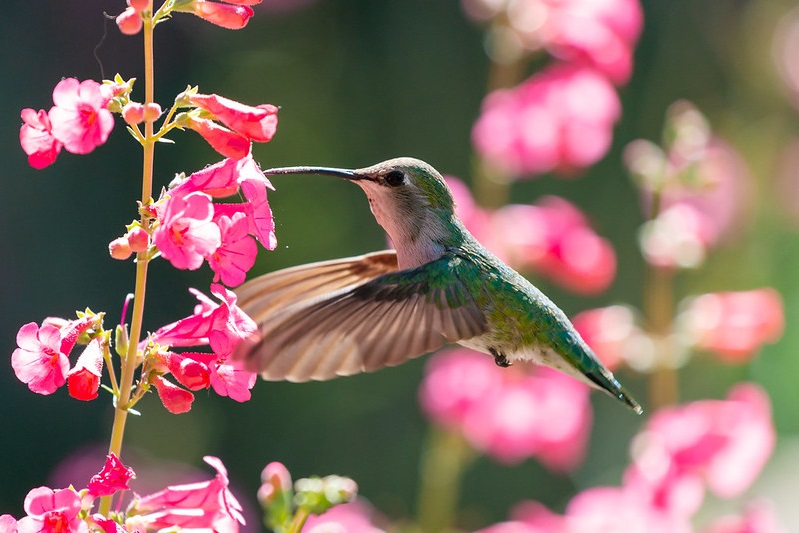

We’re here to help! Wild Yards is a completely free website that is 100% dedicated to helping you create a wildlife-friendly, sustainable yard. Read more
WildYards is reader-supported. When you buy a product through a link on our site, we may earn a comission. Every product is independently selected by our (obsessive) editors and our reviews are unbiased and objective. Read more about our mission or our privacy policy.
Hummingbirds make for some of the most spectacular wild visitors to any backyard or garden. Curious and colorful, these beautiful birds are likely to come and enjoy your flowers, providing they are bright and promise lots of nectar! But what are some of the best hummingbird flowers you’ll see drawing crowds across the year?
From hibiscus to potted plants, vines to succulents, hummingbirds have several favorite flowers they always head back to year after year. Sometimes, they don’t just enjoy the look or smell of a flower – they look for blooms they can easily drink from using their long beaks!
If you’re setting up a wild garden or backyard and are keen to host hummingbird visitors, here’s a complete guide to ten brilliant blooms these avians are sure to enjoy hunting for.
What do hummingbirds look for in flowers and plants?
Ultimately, hummingbirds are always on the lookout for nectar. While there are many different hummingbird species, these avians always tend to be on the hunt for food. There is a reason for this – did you know that a hummingbird can burn up to 12,000 calories per day?
To keep up with this massive calorie deficit, the average hummingbird needs a regular source of food. That’s where a variety of vines, succulents, and tropical flowers come in very appealing.
Hummingbirds tend to enjoy sipping nectar from long, tubular flowers that they can easily pop their beaks into and drink from. These flowers may even be considered as ‘exclusive’ to the species due to their shape! However, in practice, the hummingbird will happily eat and pollinate flowers in varying shapes and sizes.
There is a common misconception that hummingbirds will purely fly toward orange, red, or yellow flowers. In fact, they may be less fickle about the blooms they prefer than we may have originally thought.
Many common plant species are known to appeal to hummingbirds across the seasons. That, of course, is likely why you are here – so let’s take a look at just a selection of flowers that hummingbirds love.
Flowers guaranteed to excite hummingbirds
Bee Balm
From its name, it is probably easy to assume that the bee balm merely interests the odd flying insect. However, this stunning plant is a midsummer favorite that hummingbirds will normally flock to across hardiness zones four through nine. If you’re unsure of what zone you’re in, check out the USDA Plant Hardiness Zone Map.
The bee balm tends to be the first plant many hummingbird fans think of when it comes to attracting their favorite avians. This plant requires consistent moisture, making it somewhat dependent on your vigilance – but you’ll not only benefit from regular hummingbird visitors, there will also be a lovely, minty smell lingering around your garden.
Bee balm is a popular plant for hummingbird lovers as it tends to grow in shocking shades of red, ideal for attracting the attention of roaming pollinators. It’s also wildly abundant in nectar, making it a reliable spot for hummers to remember to come back to. Thanks to its appeal to insects, too, the bee balm will provide ample protein sustenance for visiting hummingbirds.
Bee balm also works well as one of several potted plants hummingbirds love, meaning you won’t have to worry about growing them out in the open unless you wish to.
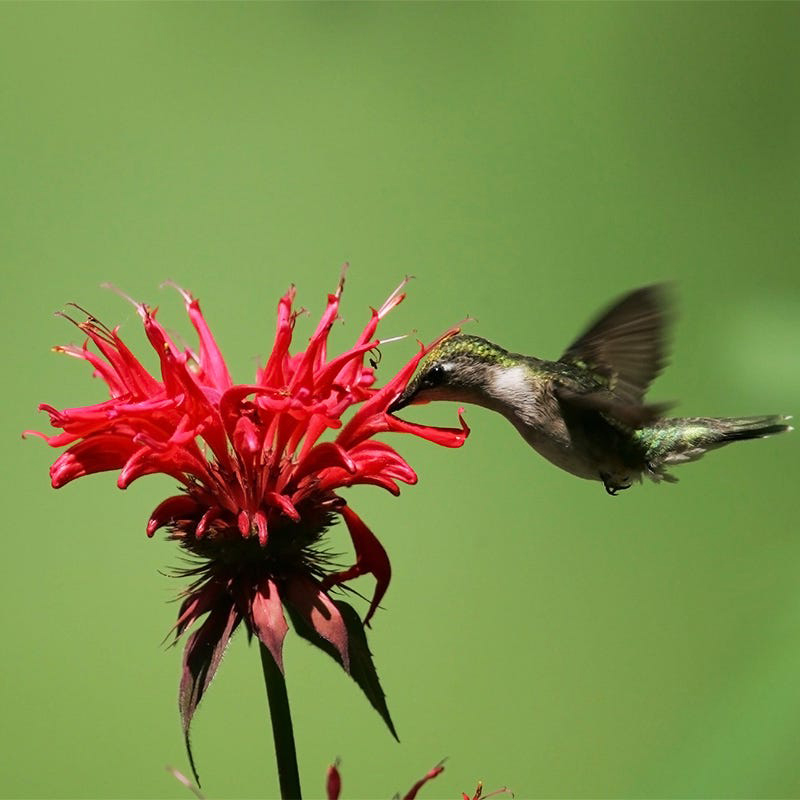
Cardinal
The red cardinal, in particular, is another common favorite of the hummingbird, and it’s a little more flexible to grow compared to the bee balm. That’s because it tends to be a little less fussy about moisture, and it’ll easily propagate from hardiness zones three up to nine.
It’s one of the multiple sure-fire perennial flowers hummingbirds enjoy from year to year. Its striking, red tubed flowers can help to add a dramatic perimeter to a flowerbed, and they will even seed on their own if you are lucky. They can grow to be up to four feet high, making them a fantastic, striking addition to your outdoor display.
Cardinals are great for attracting hummingbirds as they thrive in full sun, where these pollinators are most likely to rove around your garden. As well as demanding plenty of heat, these flowers grow well in very moist soil, meaning it’s best to plant them directly into the ground. Pack the flowerbed in with extra mulch to help retain water.
It’s best to water cardinals twice a week if there’s an absence of rain. It’s possible to grow cardinals to thrive in shaded spots, you’ll attract more hummingbirds if they’re out in the open. Be sure to mix your cardinals in with other hummer-friendly plants in this list, too, for best results.
Cardinals won’t be too hardy in USDA zones below six. It’s best to plant them in the spring for summer blooming, before covering them in compost in the fall. You should also ensure these plants have lots of space between them to comfortably establish themselves.
The red cardinal attracts hummingbirds thanks to its bold color and its beak-friendly shape. Towards the end of summer and the start of fall, it also provides abundant nectar, making this flower particularly appealing to butterflies, too.
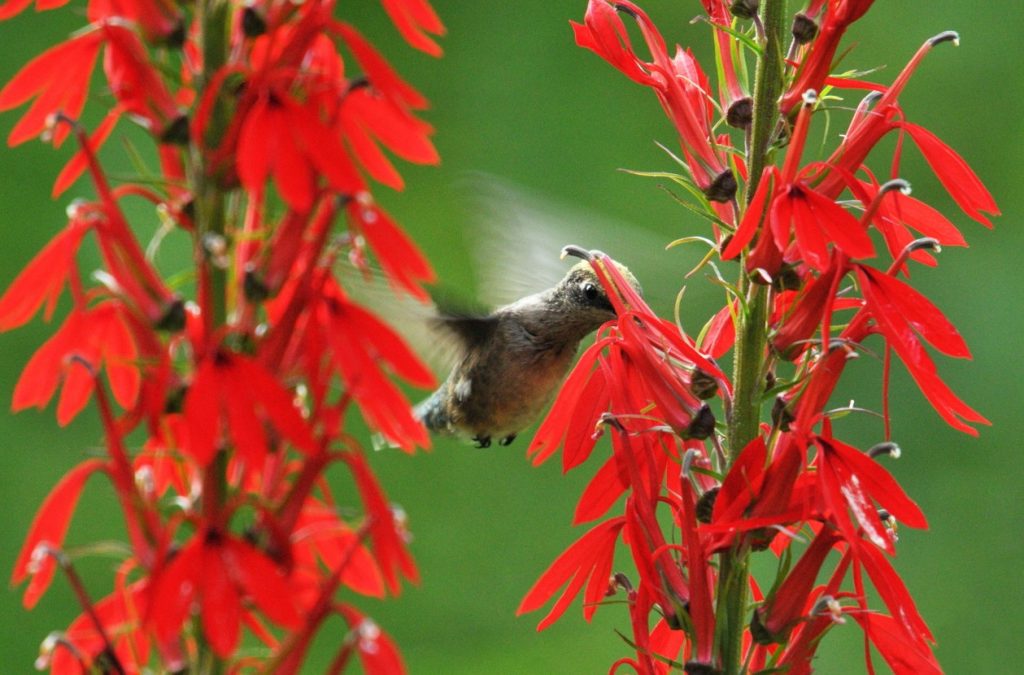
Salvia
Another perennial favorite of many hummingbird species, the salvia is an eye-catching plant with a cluster of blooms that plume forth towards the sky. This plant will normally grow well towards the end of the warm season, and you can normally see them flowering from zones three through ten.
One of the huge benefits of growing these hummingbird flowers is that they will happily bloom multiple times – and they can extend to up to five feet in height! It also does well in dry conditions, however, it still pays to water them regularly and to make sure they have adequate drainage.
Salvia is one of several plant species that hummingbirds will happily return to thanks to its reliable nectar content – it converts on its promising, bright, fragrant flowers. Generally, you can also expect any variety of salvia or sage to provide ample feeding from hummers thanks to its generic tubular flower shapes.
Salvias normally pop up in shades of violet, purple, and indigo, and they tend to be well-known among hummingbird lovers thanks to their tubular blooms.
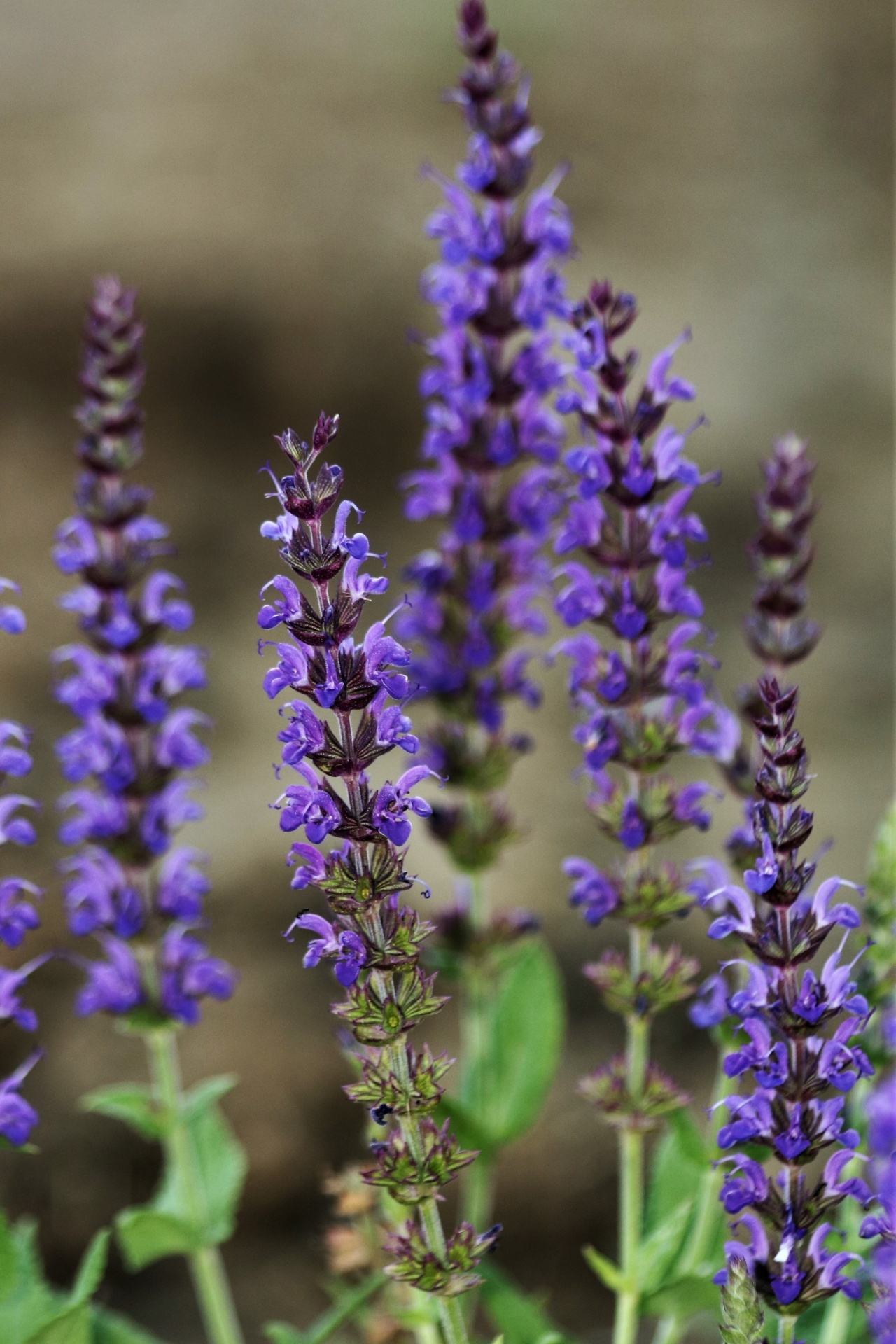
Fuchsia
When it comes to annual flowers that attract hummingbirds, you can absolutely go ‘back to the fuchsia’! Excusing the pun, these part-shaded flowers are prevalent across zones six through ten, and what’s more, there is a wild abundance of different fuchsia types to choose from.
For example, in the higher zones (nine and ten), you may do well to set up a hardy fuchsia that offers bold, red blooms. Cape fuchsia, meanwhile, do better in milder or slightly warmer zones, and won’t suffer too much if there’s little water available.
Fuchsias have curiously evolved over the years to adapt to hummingbird feeding habits. The symbiotic relationship between plant and pollinator means that hummers find it especially easy to dip in and sample nectar – their blooms are long and tubular enough to comfortably accommodate feeding.
Fuchsia tends to be an excellent ‘fallback’ flower if you are struggling to find the best blooms for your hummingbirds. They are not demanding to care for, and the best part is, that there’s bound to be a variety that appeals to you.
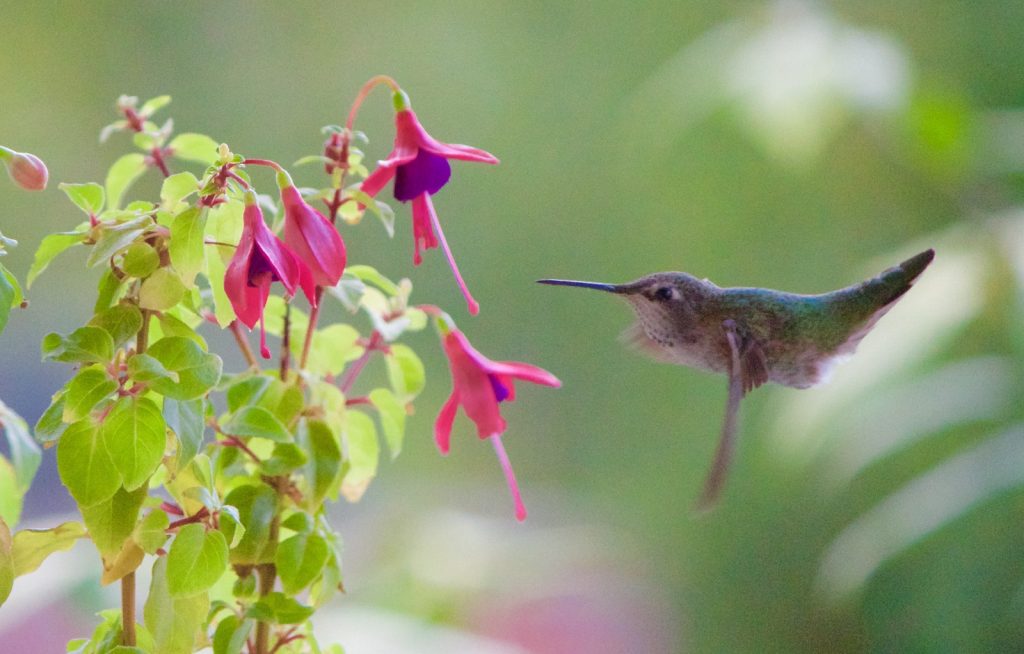
Hibiscus
Our complete guide to hummingbirds and hibiscus goes into more detail, but yes – you really cannot go wrong with this gloriously tropical plant variety if you’re encouraging wildlife visitation.
Like fuchsia, the hibiscus has varieties that differ based on the zones they grow in. For example, the tropical hibiscus will do well in zones nine through eleven – whereas you’ll find a hardy variety that does better in zones five up through eight.
Hibiscus proves popular with hummingbirds thanks to most varieties being very easy to spot! Despite some claims that hummer senses of smell are somewhat lacking, much of the appeal in hibiscus flowers stems from their heady fragrance. These plants will also grow on a wide variety of shrubs and trees, too, making them even easier for hovering pollinators to spot.
Hibiscus can take a lot of work to look after, but beyond careful watering and fertilizing, there are no reasons why you won’t be able to bring hummingbirds back to your garden during the warmer months. These are interesting-shaped flowers that our favorite avians are just the right shape for, too.
The added bonus is, that hibiscus tends to be a big favorite of butterflies, too – you’ll end up creating your own botanical paradise in no time. In fact, hummingbirds love Rose of Sharon in particular – it’s a great starting point.
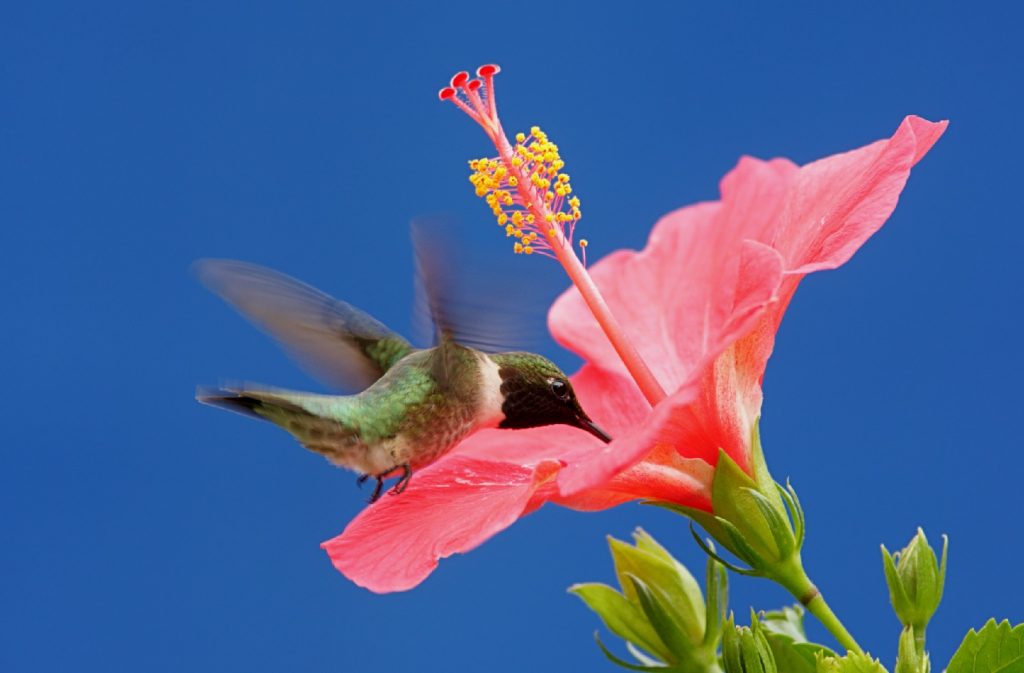
Azalea
The azalea, or part of the rhododendron, is considered a prime pick out of all the shrubs hummingbirds like to visit. Growing this border-backing plant tends to be fairly simple for zones three up through ten, providing you’re willing to fine-tune their watering and shade across the year.
Bursting in pink and orange, the azalea is a prime pollinator favorite for many reasons. It’s highly fragrant and often grows in full sun, where hummingbirds are most likely to hunt for nectar. Their tiny buds are also puckered into trumpet-esque shapes, allowing hummers to easily pop tongues in and out for a quick fix of nectar. These plants, thankfully, are also rich in sugary produce – hummingbirds will frequently come back to them.
Azalea really does grow fast, which is why it’s really worthwhile keeping a close eye on their blooms. Beginner gardeners love them – but it’s always a good idea to try and keep them under control. Drainage is vital for the azalea, as is space – they can grow to up to six feet tall, and up to around five feet wide!
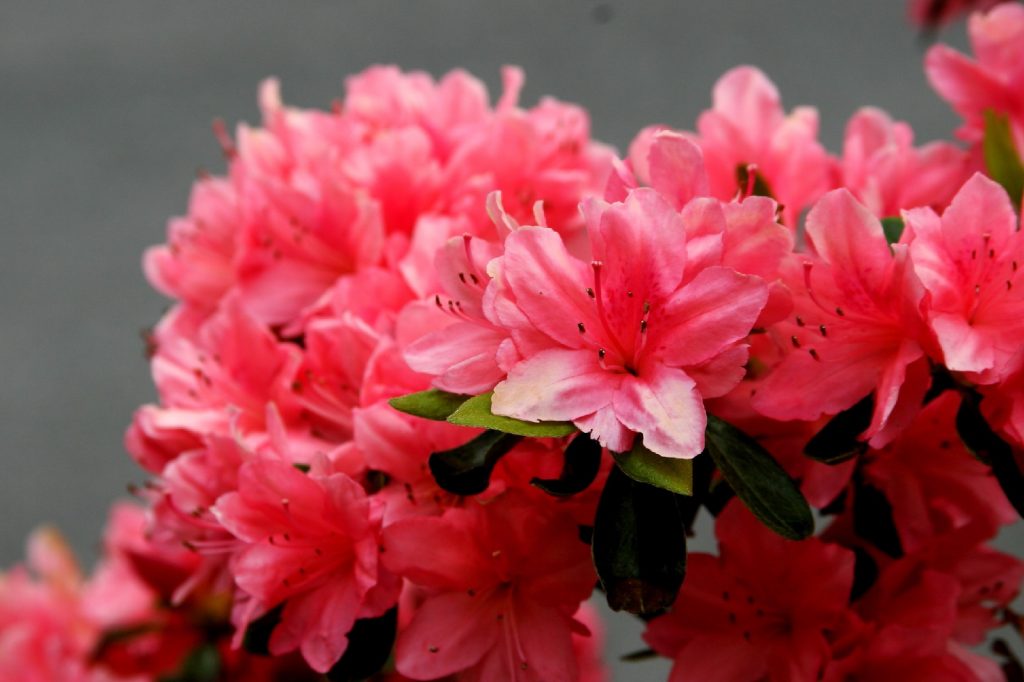
Aloe Vera
You’ll likely have heard of aloe vera as a popular beauty or skincare ingredient. That said, did you know that they also make for some of the hardiest hummingbird flowers around?
Trumpet-shaped aloe vera blossom, while not always common, makes for an ideal hummingbird attractor. Brightly growing in bursts along spikes, these flowers are hard for hummers to ignore, and are packed with useful nectar. They’ll also grow well in full sun, meaning a roving hummingbird on a desperate hunt for food will normally find blossoming aloe hard to ignore in the wide open.
Aloe vera is mainly native overseas, but they thrive brilliantly across the higher zones. In particular, these often yellow and coral-colored blooms will be very easy to look after in zones nine through eleven.
Hummingbirds adore aloe vera for their smell, too. Not everyone may assume that hummingbirds like succulents, however, aloe proves to be an aridity-defensive plant well worthy of your wild garden, and a regular winner for our avians.
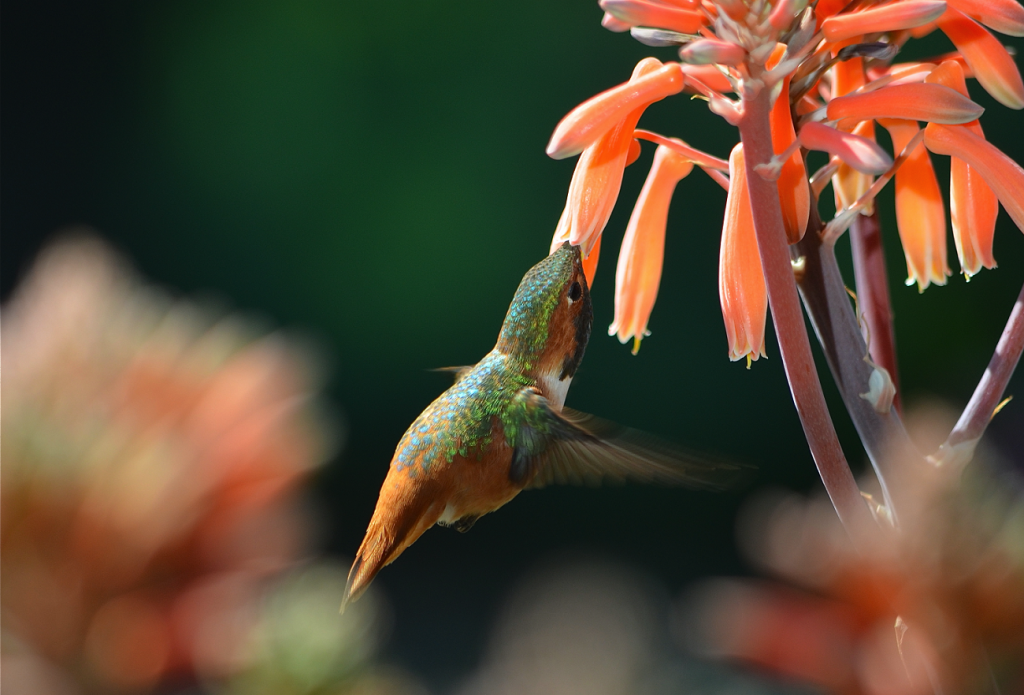
Trumpet Vine
Trumpet vines and trumpet creepers plume outwards in the shape of their instrument namesakes, and if we know anything about hummingbirds, it’s that this shape is always likely to catch their interest.
Trumpet vines are perennial plants that are also really easy to start growing from a basic level. You’ll probably do best growing trumpet creepers and vines from zones four up through nine. There are plenty of other vines that attract hummingbirds, too.
The trumpet vine looks great and all but guarantees a hummingbird crowd, however, it’s very fast-growing, and will spread its own seed around with abandon. Therefore, you’re going to need to keep an eye on its growth. You can plant some trumpet creepers that grow up to 40 feet in height!
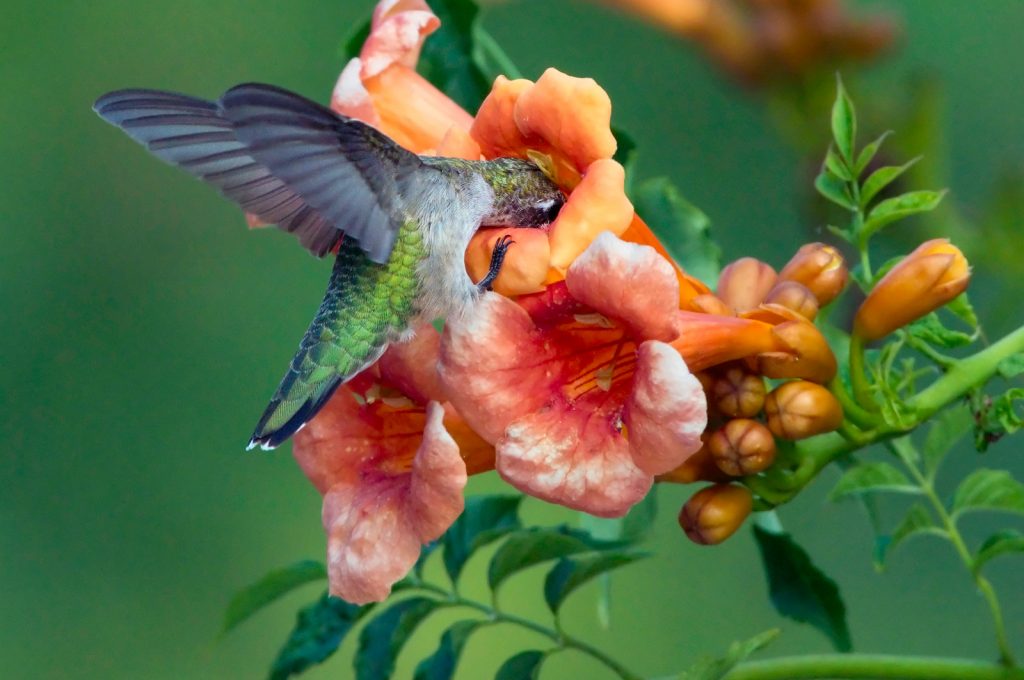
Crepe Myrtle
We love crepe myrtles! Sometimes spelled crape myrtle, these plants take the shape of hardy, staggeringly tall bushes and trees. They love to be out in the full sun, and in zones four up to nine, you shouldn’t have too much trouble getting wildlife to visit with these blooms around.
Hummingbirds love crepe myrtles – they’re fragrant, colorful, and shaped for the average hummingbird to take full advantage of. However, they are a little strange in this respect – remember the point about hummingbirds liking tube-shaped flowers?
The crepe myrtle is an exception to the rule – its flowers are widely open to all comers. Again, hummingbirds are perhaps less picky than we think – but with blooms this bold and fragrant, can you really blame them for taking a closer look?
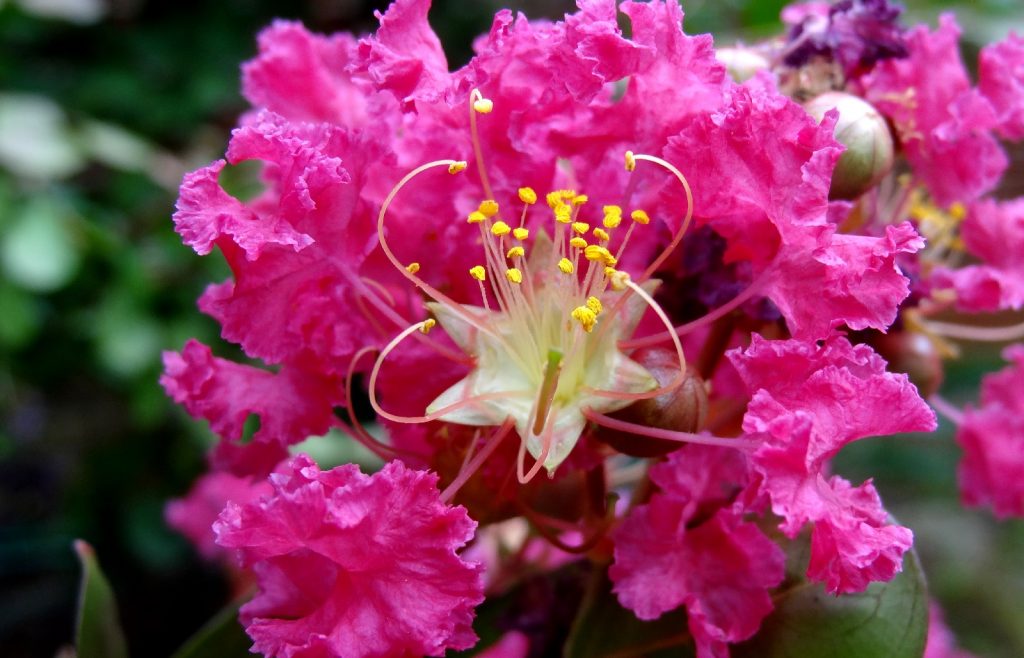
Lupine
The lupine is a curious beast as far as flowers are concerned. You’ll actually find them growing very well in wild spaces across zones four up through eight, but you’re probably going to need to grow a hybrid variety in your own backyard – it’s all to do with hardiness!
Lupines prove highly popular with hummingbirds because they tend to flower long before many pollinators’ garden favorites – helping to bring colorful birds to meadows and other green spaces long before the general blooming season. Wild lupines thrive in full sun, and while you may not find them fare too well in garden settings, their easy-feed petals are always likely to bring hummers fluttering back.
Lupines won’t always last for too long, even if you do choose to grow hybrids, but they have a special place in the spring crop. That’s when you may not always see much on the platter for hummingbirds – and providing your own lupine group has access to full sunshine, there’s no reason why you can’t grow your own.
These lovely flowers are now bred to show off a palette of colors from yellow and red to blues and purples. Quite frankly, there seems to be a lupine for every taste.
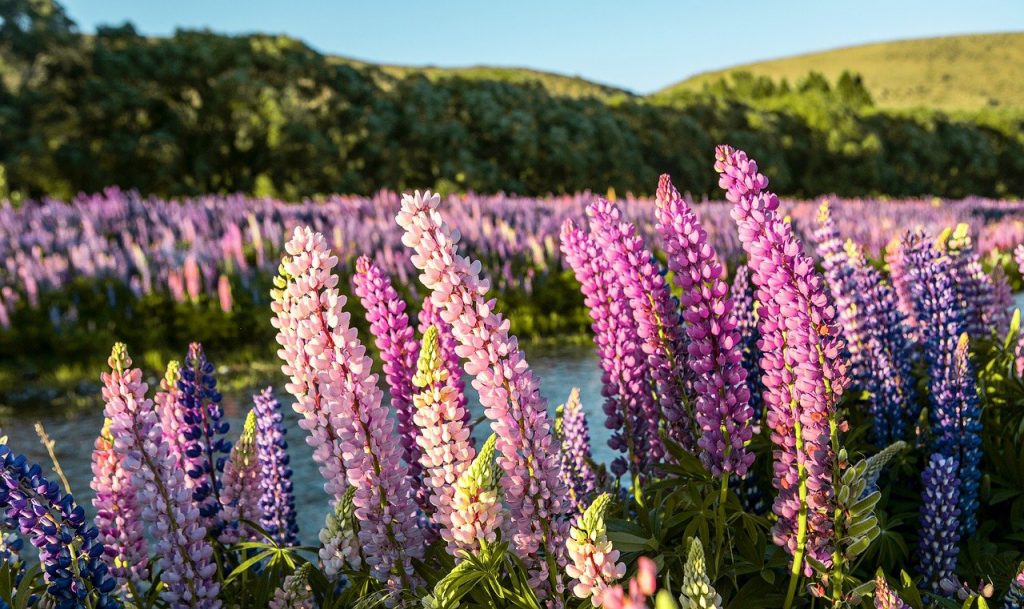
Petunias
It’s easy to understand why hummingbirds find petunias irresistible! The initial attraction is likely to be their enticing colors – these bold, blousy flowers arrive in a striking red, bright orange, yellow, lemon, lilac, or deep blue. Often, the shading on petals pales towards the center of the flowers to encourage hummingbirds to find their next meal – they narrow in size, directing them towards an ideally shaped trumpet from which they can feed, where the nectar is stored.
Widely regarded as annuals, hardy petunias can be grown from seed, bought as seedlings, or fully grown plants. Preferring full sun, the more they get, the more flowers they’ll produce! Prudent gardeners can overwinter them indoors, thus having mature plants ready for a second summer season. They do not tolerate drying out or cold temperatures – but neither do hummingbirds!
As versatile plants, petunias can grow in containers or in the ground. A great tip if you want to watch your local hummingbirds feed from petunias while indoors is to try growing your plants in a hanging basket by a window.
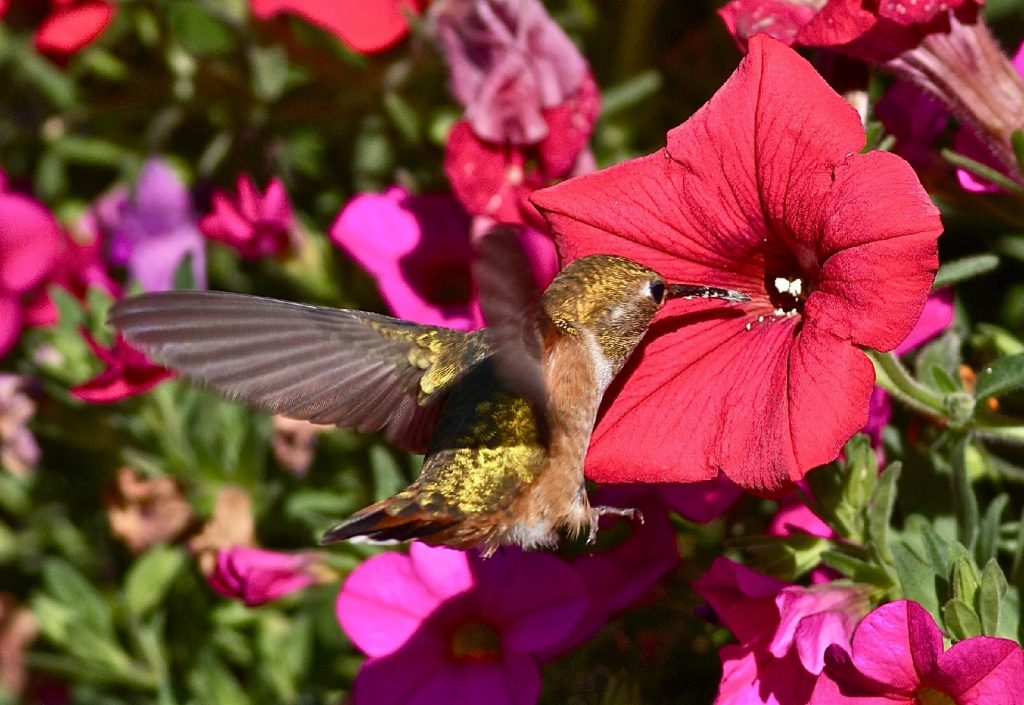
Begonias
Begonias can grow quite tall but are mostly known for being compact and bushy – as regular visiting diners, hummingbirds occasionally spring upon these plants. They can also stand to eat from them, rather than hover above the ground, helping them to conserve energy (which hummers, frankly, need lots of!)
As begonia flowers are formed tightly close to each other, hummingbird diners don’t have far to travel between courses – the same specific birds visit them for this reason. Begonia flowers are brightly colored and form neat petals, clearly showing off where your fluttering visitors can hope to get nectar from.
Surprisingly, begonias aren’t always the best for nectar – with many species being infertile. That won’t stop hummers approaching them, but they’ll do little to help pollinate your yard.
Thankfully, growing begonias is nice and easy – there are over 1,000 species with flowers of various colors, too, offering plenty of choices! Begonia flowers come in a range of colors from deep ruby red to white, with various shades of pink in between. Begonias often have a shallower root formation than neighboring plants – so water them carefully without drenching them. If you let them dry out, they may struggle to recover. You can easily grow these plants in USDA zones two through 11.
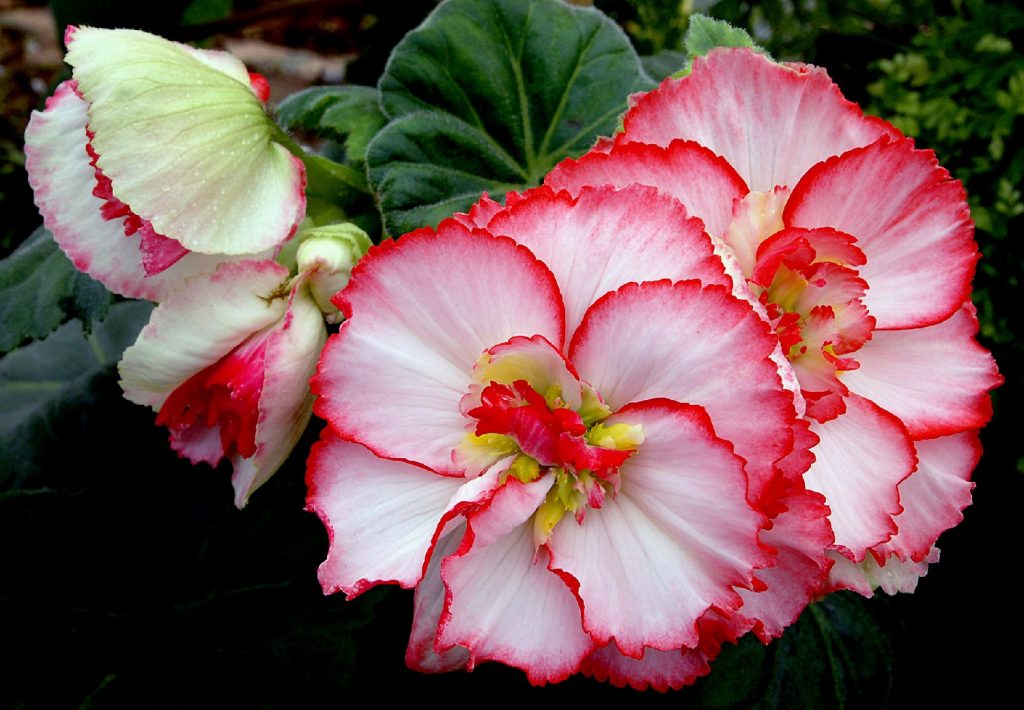
Lilies
Grown from bulbs, these dramatic plants are bold and impressive – and you can plant them in clusters or individually. They usually bear simple, star-shaped heads on tall, upright stems with streamlined leaves. Lilies attract hummingbirds by displaying copious amounts of pollen in their open center, giving easy access to these beautiful birds.
Tiger or Columbian lilies, in particular, are highly attractive to the rufous hummingbirds – but they’ll tend to attract most hovering pollinators. Due to their potentially tall height, hummingbirds can usually only access lily nutrients by hovering next to them – you can expect them to grow up to eight feet from the ground.
Lilies are easy to grow in well-prepared soil with good drainage. They do equally well in containers, pots, and tubs. These plants thrive in temperate climates and are found in regions from subtropical to the northern hemisphere. They are perennials, spreading from bulbs or rhizomes – creating smaller, additional bulbous growth depending on conditions. They’ll thrive in USDA zones five up to nine.
Flowering from late spring and throughout summer, lilies have rich gem-like coloring, with flowers spanning an average of six to ten inches. Savvy hummers find lilies easy to spot and rich in bountiful nectar.
You’ll need to water lilies regularly during the hottest months. Be careful growing them if you have cats, as some species produce toxins that can cause kidney damage.
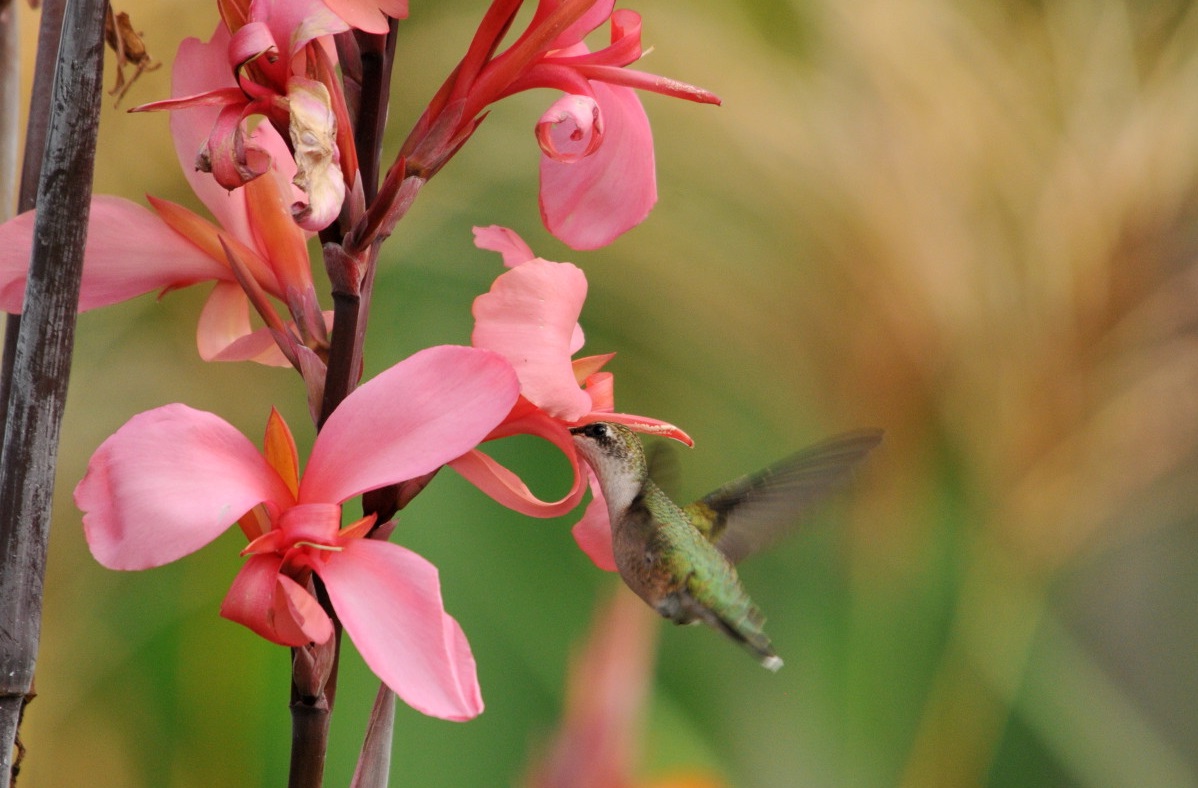
Wisteria
With a lush abundance of decorative flowers forming on a curtain of attractive leaves, these stunning vines cling to supporting structures – so, plan ahead. Attached to walls, trellis, or frames, they form bird-friendly perching opportunities. Wisteria’s abundance of flowers allows hungry hummingbirds to swiftly swoop from one cluster to the next.
Wisteria can also develop strong woody stems and branches. Acting almost like scaffolding, hummingbirds can sometimes choose to stand and eat on these spots or to take a break from hovering between courses!
Wisteria flowers are tubular in shape and dangle down in a grape-like fashion. This means unless competitors for nectar have the means to position themselves to gather it, hovering hummingbirds have a feeding advantage! Hummingbirds generally breed from March to July, which is the perfect time for wisteria to come into bloom.
Wisteria thrives in full sun and in well-draining soil – and it can be trained to climb from a young plant. Simply choose the spot in your garden where you’d like to plant it and guide growing shoots by fixing them with a slightly flexible attachment to brick, wood, or cane. Then, ensure that the plant has enough space for the girth of the stem to thicken.
Black Dragon Wisteria is one of the best species to grow in full sun or semi-shade (where hummers are likely to travel). It’s hardy in most zones, though USDA zones 3 through 9 are ideal for most species.
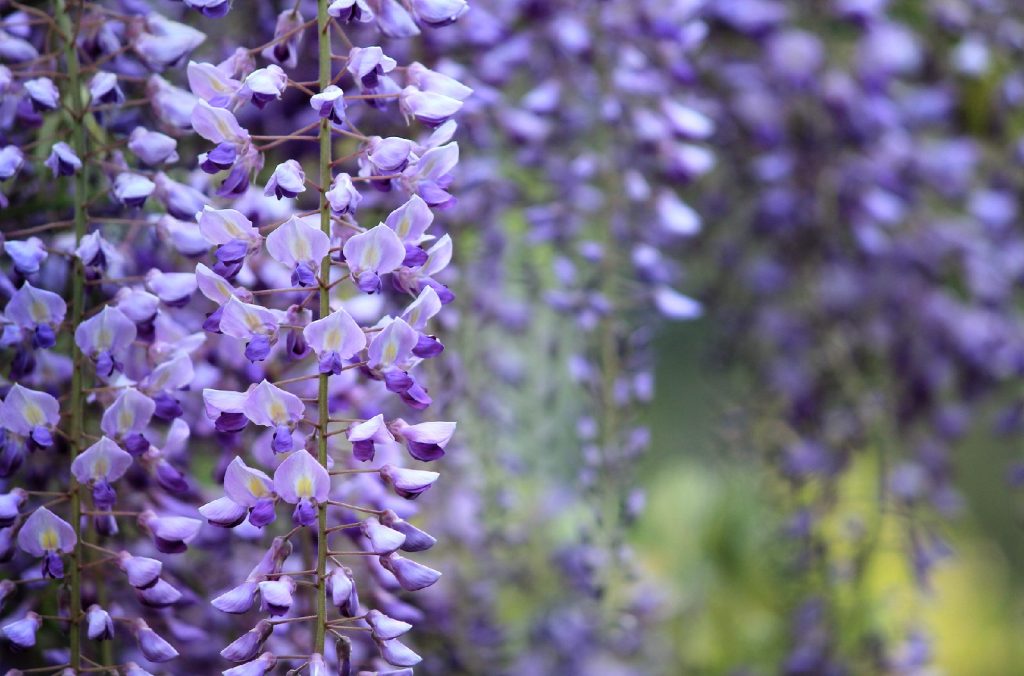
Roses
Say it with roses – these popular perennials can attract hummingbirds from their striking colors alone, but not for their nectar caches. Hummers may toy with them for nectar but generally do not get much nourishment from them – they find the aesthetic appealing more so than their delicate scents.
While not ideal for nectar feasts, what various roses do well is attract hummingbirds to your garden to feast on insects (such as aphids and greenflies). The striking, large heads of roses, on display for several months, are highly visible to birds in flight. Attracted by a full range of reds, oranges, yellows, and pinks, roses will entice hummers – but other plants in this list are more likely to keep them visiting.
Rose heads can be tightly wrapped or slowly unfolding – and it’s the tightest of flowers that may not provide too much interest to hummingbirds. Your winged pollinators are likely most attracted to the Californian wild rose and the rosa rugosa species most of all – they have quite flimsy petals and offer wide-open access to what little nectar is available.
Roses thrive well in rich soil that’s moist and draining well – and will be more than happy to bloom in full sunshine, right where hummers flutter the most.
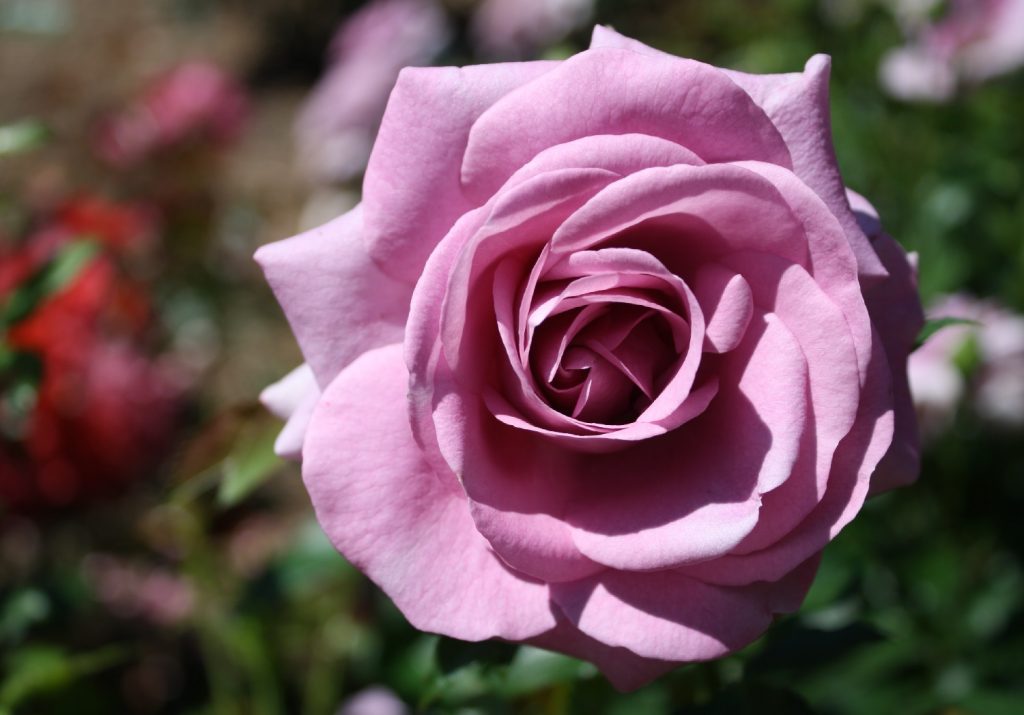
Morning Glories
This vine-like plant shows an animated display as it closes up and takes siestas! During midday heat, they fold petals until the temperature becomes more comfortable, thus displaying their ‘glory’ in the morning which happens to be when hummingbirds are looking for a meal. Their tubular-shaped flowers are sought avidly by hummingbirds, often blooming in blues, reds, lilacs, and purples that will catch their eyes. They are reliable nectar sources, meaning hummers will frequently head back to them.
Morning glory flowers are formed on fast-growing stems which easily attach to and cover trellises, walls, fences, and frames. It is often the tubular-shaped, bright yellow central trumpet that entices hummingbirds to explore the whole plant, moving from one flower to another. Morning Glory has a longer flowering period in milder zones – and be warned, they grow extremely fast, even in dry conditions. If given too much free rein, these flowers can soon take over a patch of your garden before you realize it. Hummingbirds are unlikely to complain, though it’s best to try and grow a healthy variety of other plants close by.
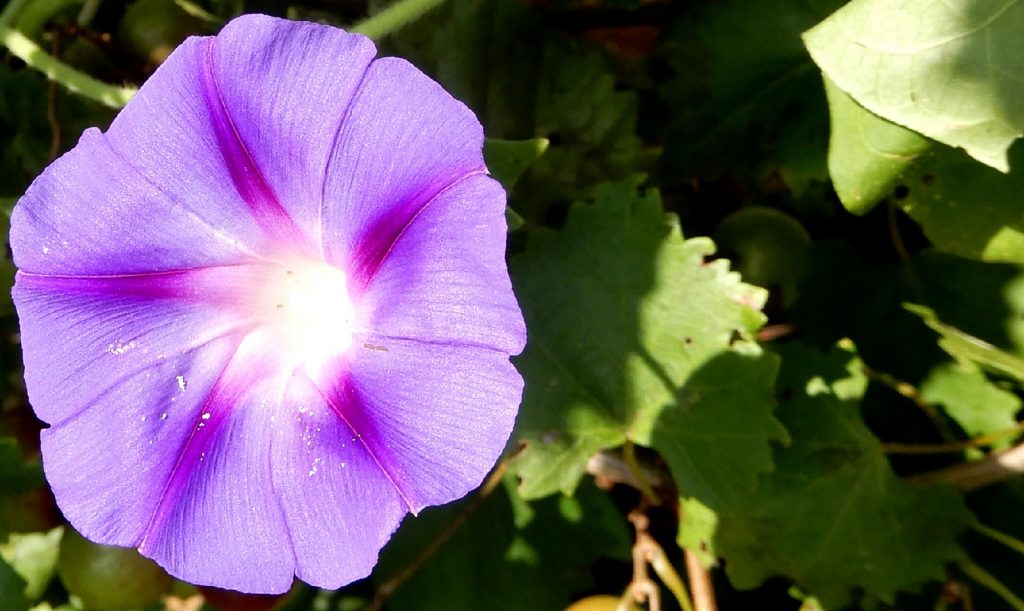
Snapdragons
Snapdragons arrive in a beautiful array of colors, with their bright red, orange, deep pink, and deep yellow varieties being particularly appealing to hummingbirds. As display plants, snapdragons are usually grown in groups in flower beds or containers. They flower repeatedly and, if planted in intervals, the colorful show will go on for months into the fall, encouraging hummingbirds to become regular visitors!
Snapdragons typically flower from June to October and will likely attract hummingbirds when they’re most likely to flutter around your garden. They are short-lived plants, but windborne seeds can self-set and grow new plants when you least expect it. From setting seed to its flowering, you can potentially grow a snapdragon in as few as two months!
They’re sometimes referred to as ‘cool season bloomers’ because in extremely high temperatures they suspend flowering until they cool down. Normally considered annuals, they can become perennials in milder zones – with care. Snapdragons prefer to live in well-drained soil in full sun. They’re sometimes mistaken for foxgloves, but don’t worry – as they will welcome hummingbirds, too.
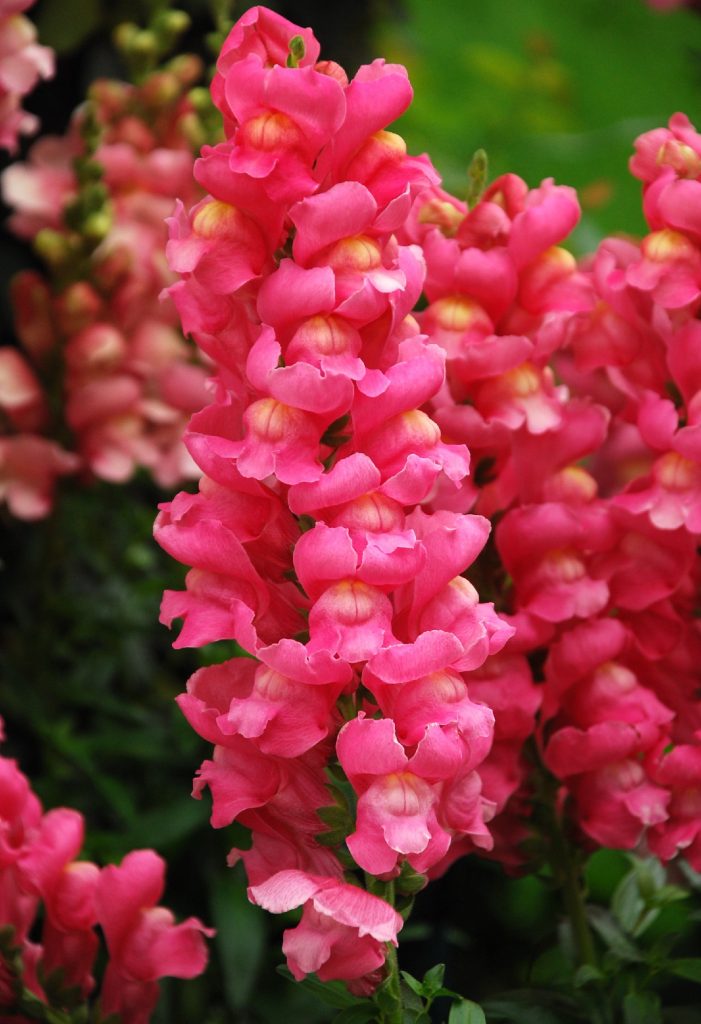
Sunflowers
It’s easy to understand how sunflowers got their name – they turn their heads to follow the sun’s path as it traverses the horizon, in a heliotropic action. As such, hummingbirds find these plants very easy to see from a distance – helped by the fact that some varieties can grow up to 20 feet tall!
Sunflowers are nutrient-rich with a proportionally high amount of nectar to boot. It’s stored in a compact collection of small, cup-shaped cavities on the central disc of each flower. Hummingbirds hover within reaching distance and will probe each individual cavity with their beaks and tongues. Sunflowers also make great breeding grounds for other pollinators, such as butterflies. Other insects find sunflowers bright and appealing, meaning hummers will also find plenty of protein to feed on.
Sunflowers are annuals grown from seeds. They can self-set at the end of a flowing season – and can be grown on a grand scale as crops or individuals in pots. As individual plans, tall sunflowers may require support in windy, exposed areas. They tolerate high temperatures and thrive in sunny spots.
Once discovered, hummingbirds may revisit the same sunflower several times – they are highly reliable for all kinds of food! Sunflowers are hardy and grow well in zones from four to nine.
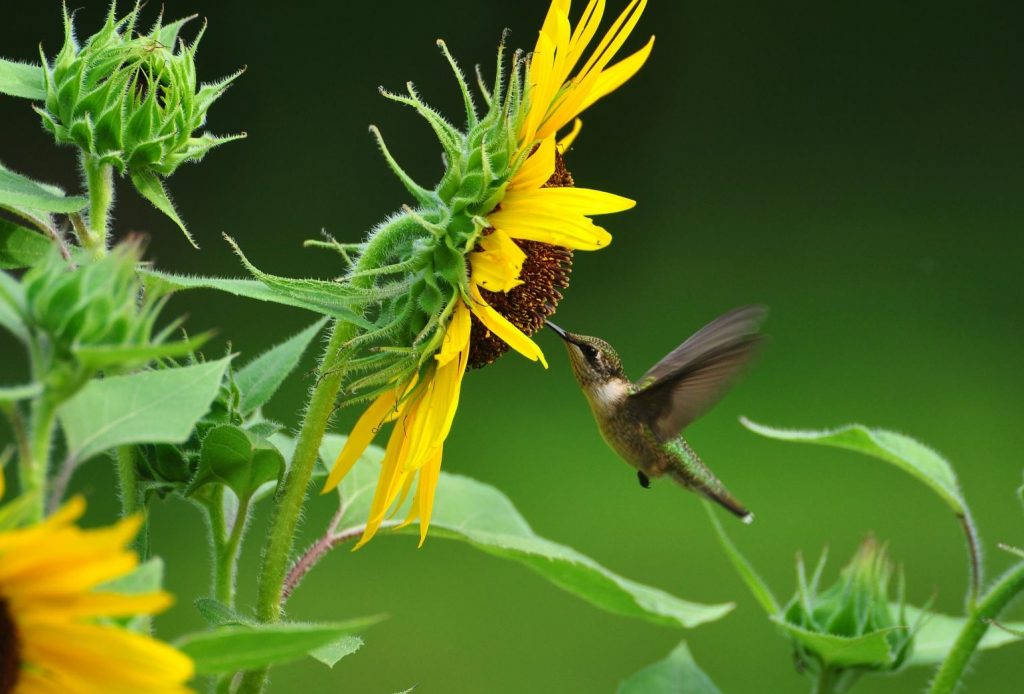
Lantanas
Lantana is bright, colorful, and reliable for nectar – meaning hummingbirds will frequently revisit these plants during summer. The Dallas Red lantana is a particularly luminous scarlet that is a firm favorite of US hummers. Hummingbirds hover easily at lantanas’ accessible heights (between three and six feet) and will probe beaks into its many accessible trumpet flowers. The lantana will typically flower many times over a season, meaning the same birds may return for a refill from time to time.
On a cautionary note, lantanas are toxic to some animals and can cause an allergic reaction if touched. Grow them towards the edge of your yard to welcome hummingbirds and steer children away!
When treated as perennials, the same hummingbirds may return to feed on lantanas the following flowering season. As annuals, lantana will not spread so extensively and are easier to control. The younger the plant, the more water your lantanas will need – and much like other plants on this list, planting them in full sun is a must.
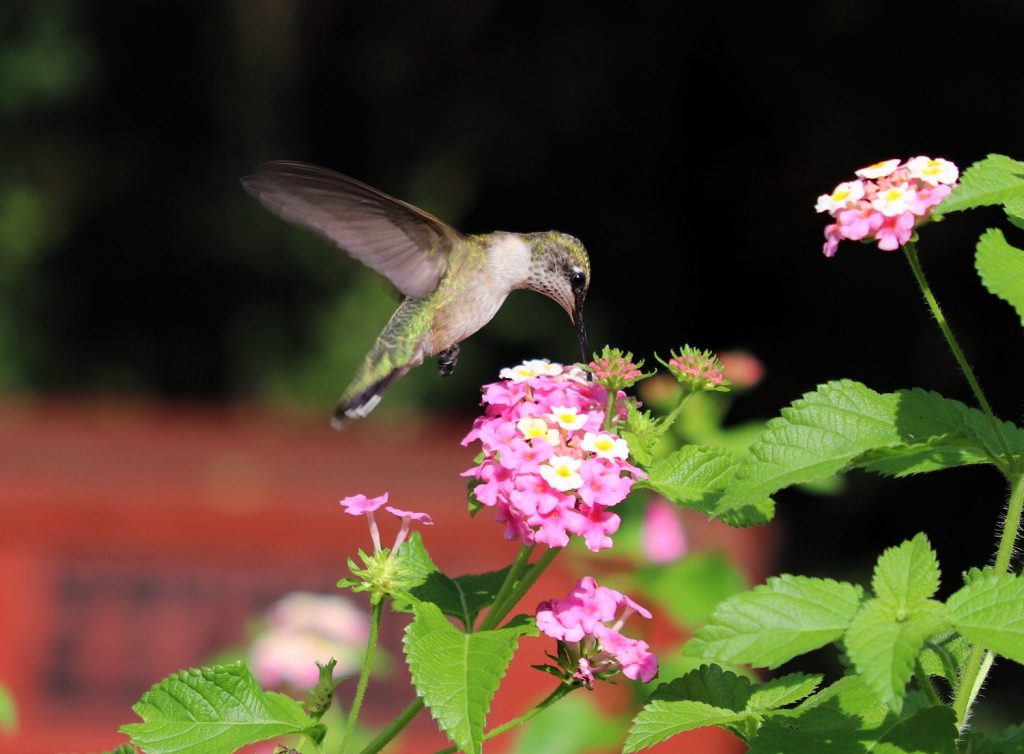
Impatiens (Busy Lizzies)
Impatiens plants are extremely easy to grow and cultivate, and while they may not be ideally shaped for hummingbird beaks, their vibrant colors and promise of nectar do plenty to keep these pollinators coming back for more. Unlike many of the plants in this list, impatiens do very well in shady spots – and while hummingbirds won’t always flutter out of the sun, it’s good practice to have a few appealing blooms across sunny and shaded spots.
Impatiens will disperse far and wide thanks to their exploding pods, making them ideal attractors for hummingbirds you can rely on from season to season. If you’re worried about finding impatiens that are shaped best for hummingbird beaks, try growing Impatiens arguta or Impatiens balsamina – these bloom more tubular flowers.
In warmer zones, impatiens will grow rapidly as a perennial species. As such, be prepared to take clippers to your plants if you see them getting out of control – they will take over even a large flower bed if left to their own devices. You’ll need to water these plants regularly, but their soil needs to drain through.
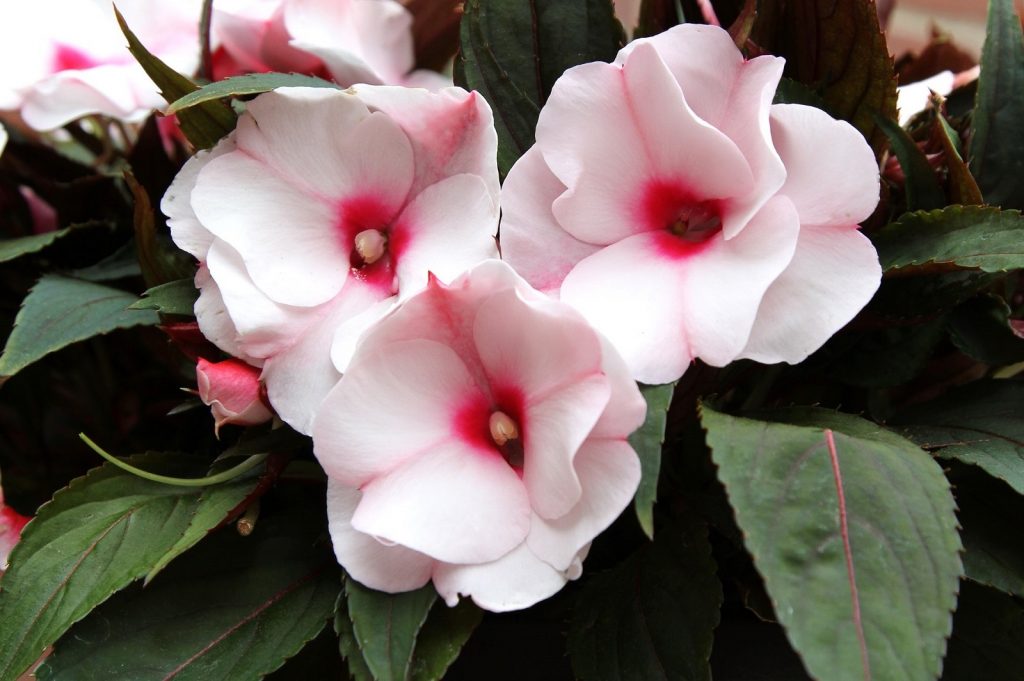
Dipladenia
Dipladenia is a tropical plant from Brazil, sometimes known as ‘Brazilian Jasmine’. It’s also often referred to as the rock trumpet. It has a bushy habit with flowers forming on stems that hang down – they’re brightly colored shades of red, pink, yellow, and white, ideal for catching the eyes of roaming hummingbirds. It’s a reliable, frequently-flowering plant with nectar held in trumpet-shaped cavities, a perfect shape and fit for their long tongues.
Due to its origins, the dipladenia is most comfortable in warm climates and where temperatures don’t fall too low at night. Temperatures below 65 degrees Fahrenheit are likely to stress these plants out – ideally, they will have a home in a well-draining spot with lots of light. The dipladenia does better out of direct sunlight, though hummingbirds are likely to spot its flowers easily while hovering around an open garden space.
In ideal conditions, dipladenia will have long flowering periods, sometimes extending beyond two seasons! To enhance flower production, it’s good to fertilize dipladenia with liquid plant food once a month – and water regularly, but don’t over soak it.
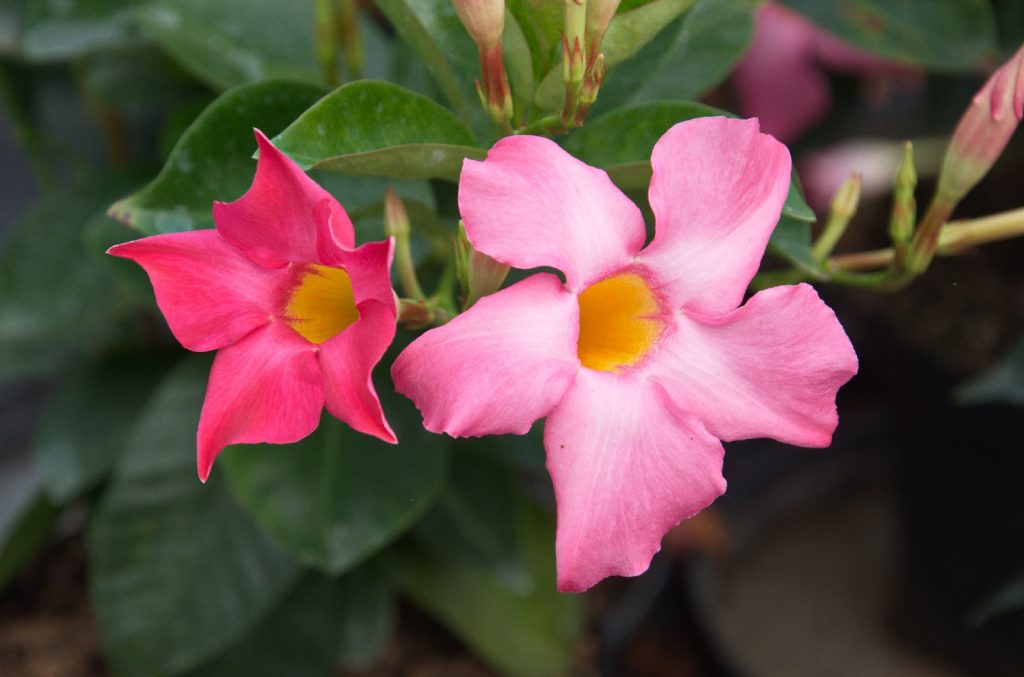
Clematis
This popular climbing plant is often referred to as the queen of vines – it’s very easy to grow and train, providing a fantastic vertical trail for hummingbirds to follow and feast from. Hummers are attracted to the colors of clematis flowers which can span as much as 6 inches – making them extremely easy for nectar hunters to spot.
Often blooming in a flat formation, petals surround central spots containing reliable nectar – meaning hummingbirds will learn to come back to them time and again. Clematis flowers emerge in deep pink, purple, and blue – from late spring to early summer, lasting until fall. They provide visiting hummingbirds with a reliable source of nectar long into seasons when other flowers may give up the ghost.
To thrive, clematis flowers need a minimum of six hours of full sun per day or an average of 42 hours per week. These plants thrive in well-drained ground or pots, though be careful not to get the roots too hot – they will dry out if you’re not careful.
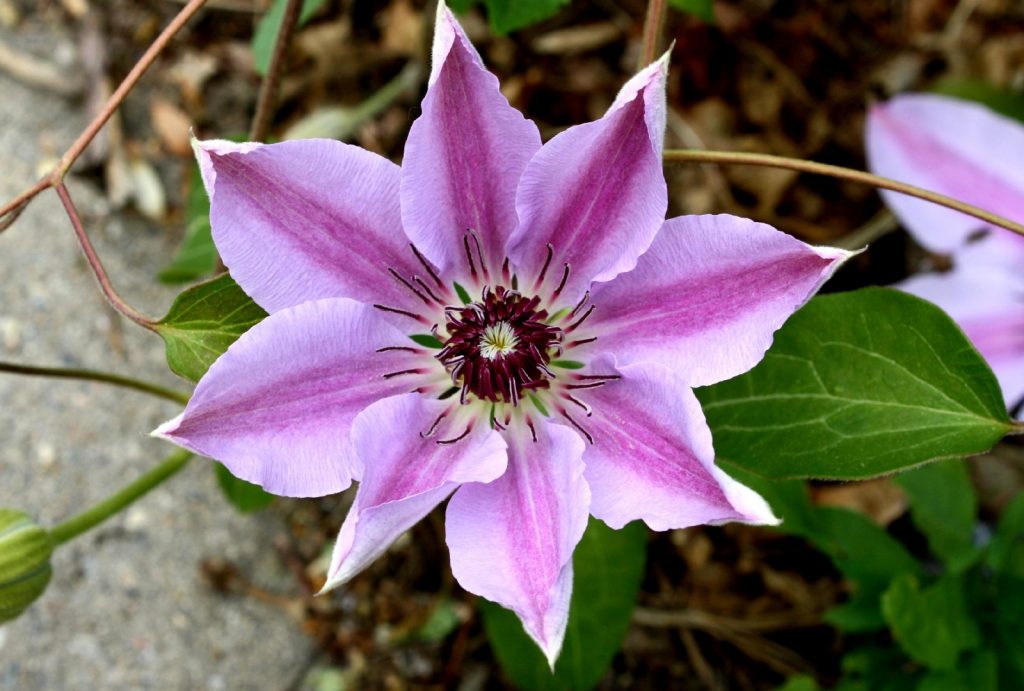
Calibrachoa
Calibrachoa is a blossoming plant that ticks most of the right boxes for hummingbirds, presenting bright trumpet shapes that are obvious and easy to eat nectar from. This colorful nightshade will typically burst in shades of pink, red, orange, and purple. They’ll normally present flowers from spring to early September, meaning they are widely present when hummingbirds are mating and feeding.
These are sun-loving plants that should need slightly damp soil and occasional fertilizing – perhaps once or twice a month. These plants are some of the hardiest hummingbird-friendly growths against the heat of full summer, as well as some of the more common diseases to befoul other blooms in your garden.
It’s a great plant to store in containers and hanging baskets. The extra benefit to calibrachoa is that they will keep blooming with no need for manual effort – always obvious for hummingbirds to spot and feast from whenever they wish.
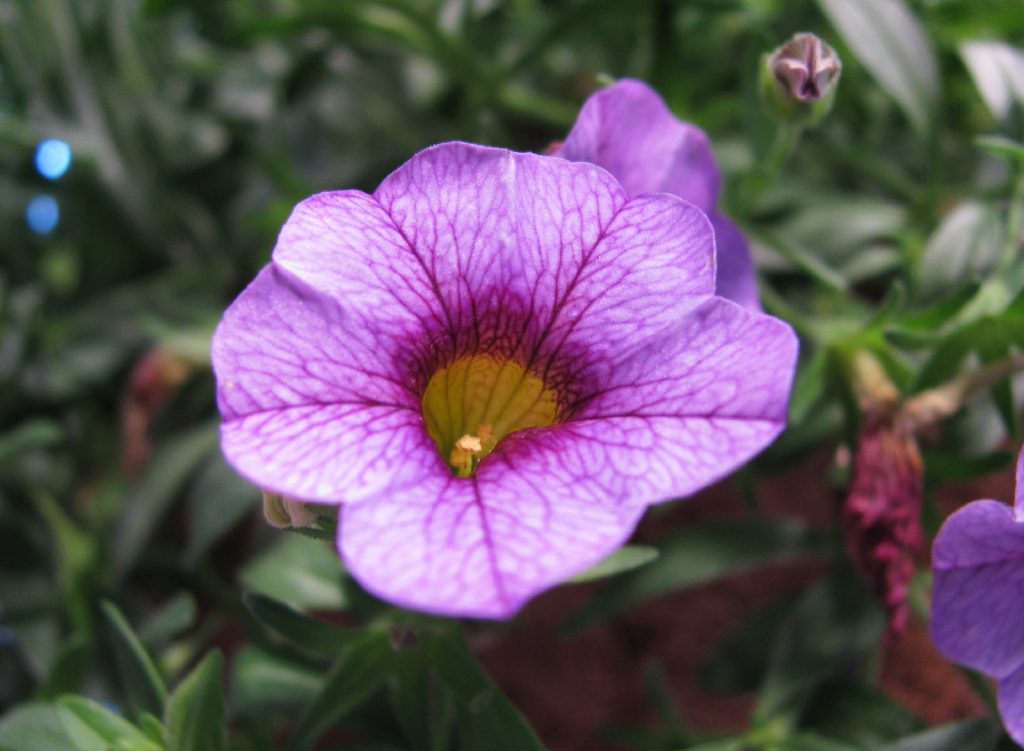
Honeysuckle
Honeysuckles are prolific growers with attractive flowers and a distinct scent. As hummingbirds don’t rely entirely on scent, they’re more appealed by some of the deeper reds and the fact that in warmer seasons, this plant will sprout and bloom with very little encouragement. It’s amazingly reliable for nectar and will continue producing well into the fall.
Honeysuckle flowers come in various colors, and some offer multiple shades and splashes. You’ll commonly spot pinks, oranges, yellows, lemons, and whites. Their flowers typically look exotic with slender, curved, or tightly curled petals – and a delicate appearance.
Many honeysuckle flowers have trumpeted-shaped openings, which are of course great for hummingbirds to dip into.
On a cautionary note, the honeysuckle, known as Loniceda Sempervivens, is sometimes confused with the Japanese Lonicera Japonica. This is highly invasive and can strangle other plants!
Be warned that once you have honeysuckle rooted and growing in your garden, it will normally want to stay put – it’s notoriously difficult to get rid of! Thankfully, training it to grow and climb will ensure hummingbirds have a delicious trail of nectar they can always follow.
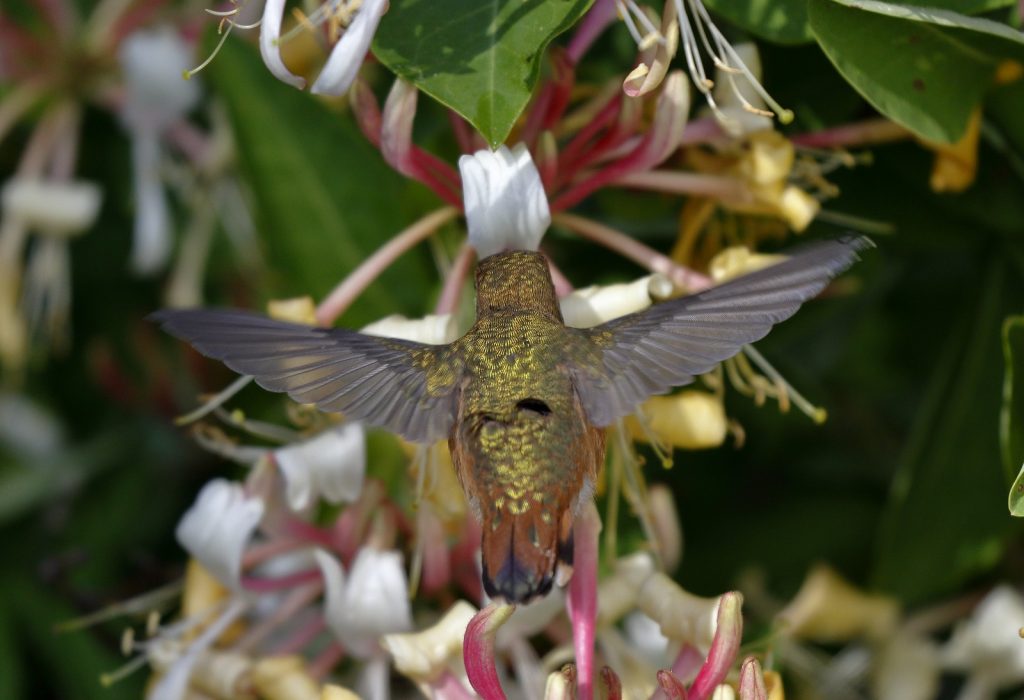
Mandevilla
Mandevilla is a fast-growing, visually rewarding plant with trumpet-shaped, nectar-bearing flowers. Its flowers range from deep red, scarlet, and deep pink through to paler pink hues – ideal for attracting attention from visiting hummingbirds. As you may know by now, the trumpeting petals on mandevilla are easy for hummers to probe into and feed from, too – making them a firm favorite among visiting hoverers.
Mandevilla is easy to care for, providing you can replicate its tropical origins. It loves warmth and humidity – it’ll need regular watering and a little intermittent shade – meaning you can house them in full view of the sun, where hummingbirds are most likely to be hovering around looking for their next meal.
If you inadvertently allow mandevilla to dry out, don’t despair. If it’s in a container rather than the ground, place it in a semi-shaded area and give it a drink – but don’t overcompensate for the drought by drenching it. These plants also thrive well with magnesium added to the soil.
They’ll grow hardiest in USDA zones 10 and 11, and if you’re lucky, they can grow up to 20 feet tall – though taller specimens are not ideal for attracting hummingbirds as they tend to hover closer to the ground! It may be worth cutting carefully to prevent it from getting too tall.
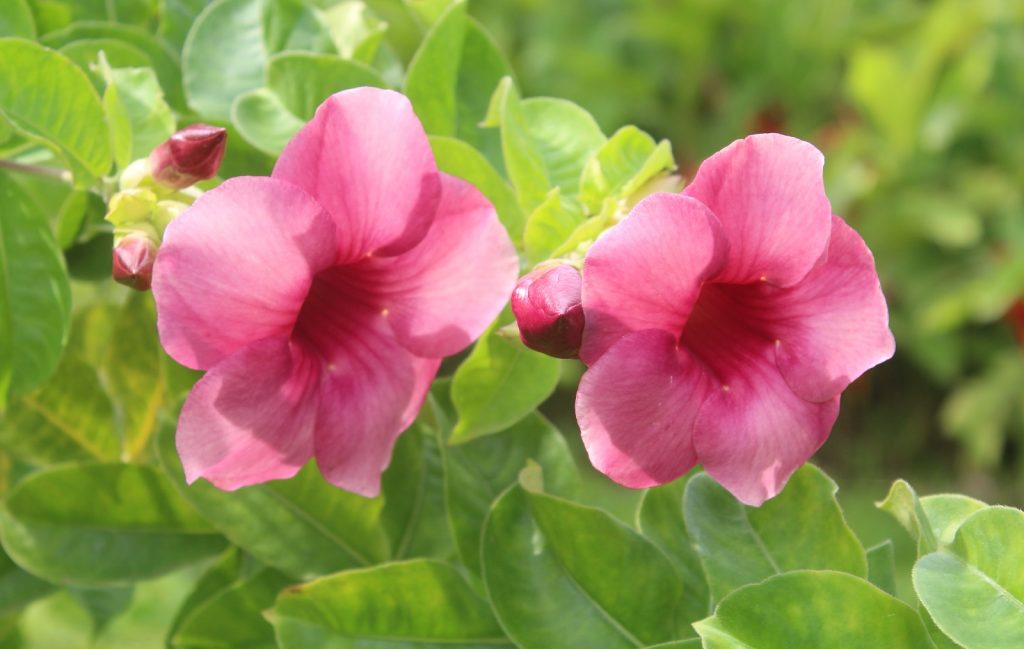
Lavender
Famous for its strong scent, lavender attracts hummingbirds mainly thanks to its reliable nectar pockets. These plants are highly reliable for hummingbirds thanks to their shape – lavender plants are particularly bushy with slender, elongated leaves and tall, leggy stems topped with flowers. They will normally provide a large clutch of flowers for hummingbirds to keep heading back to – and they’re perfectly shaped for hummingbird beaks, too.
Arriving in purple, lilac, maroon, and pink, lavender’s colors also work hard at inviting hummingbird visitors. This plant’s stems are usually spread several inches apart, allowing hummingbirds to flit from stem to stem, hovering by those towards the center of the plant.
Lavender grows hardily in open sunlight and will require soil that drains water thoroughly – though don’t starve your plants of H2O, as most lavender will require regular watering through its main growing seasons of spring and summer. After most lavender has come to full bloom, it shouldn’t need to be watered as frequently.
Lavender likes alkaline soil, so the odd dose of potash may perk it up if needed. It can become stressed in drought, but don’t give up on it too soon – this plant is a born survivor and can bounce back with a little extra TLC!
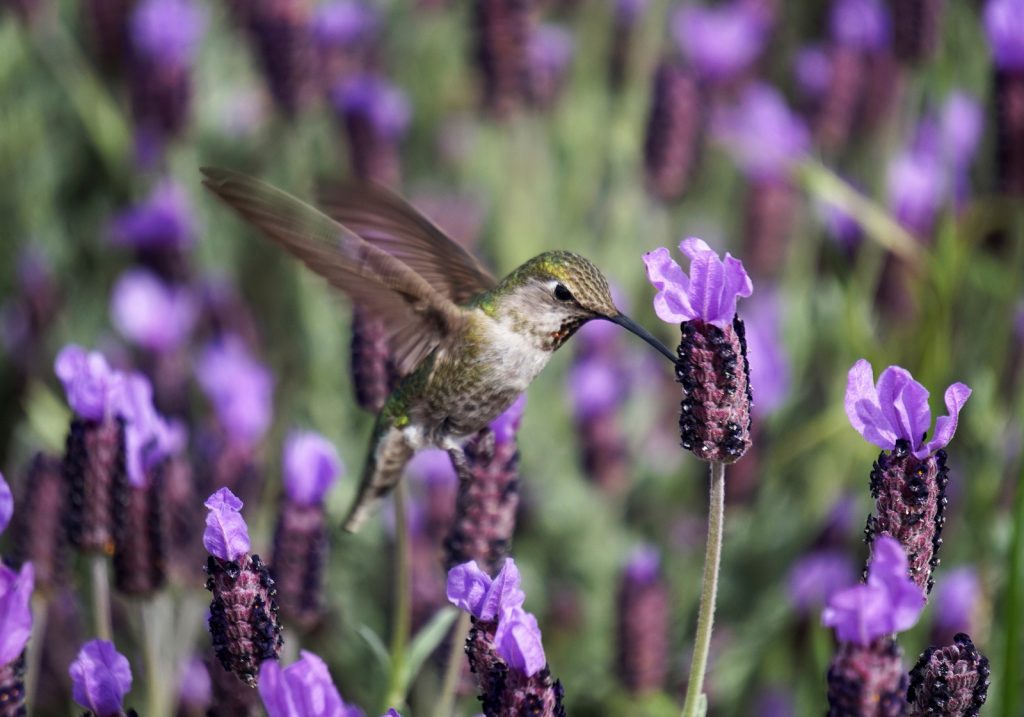
Zinnias
These garden gems come in a variety of appealing colors – in vibrant oranges, purples, and reds, perfect for attracting hummingbirds and many of the insects they frequently eat for protein. Zinnias grow from a mere six inches up to four feet tall – hummingbirds can easily hover to extract nectar from taller specimens, so don’t worry about clipping them.
Zinnias are some of the most reliable plants you can grow for pure nectar, meaning that hummingbirds will remember to come back to them if you continue to grow them season by season. If you’re growing zinnias in zones six through eight, you can expect them to grow as annual shrubs – but up to 11, they’re hardy perennials.
As annuals, zinnias need to be set in well-draining soil and be raised in full sun for optimum growth. They enjoy humidity and need regular watering – but, much like lavender, don’t overdo the quantity. It’s important to moisten roots, but not drown them.
They are tough, obliging plants and can light up a dull border in the ground or become a sensational centerpiece in a strategically placed container.
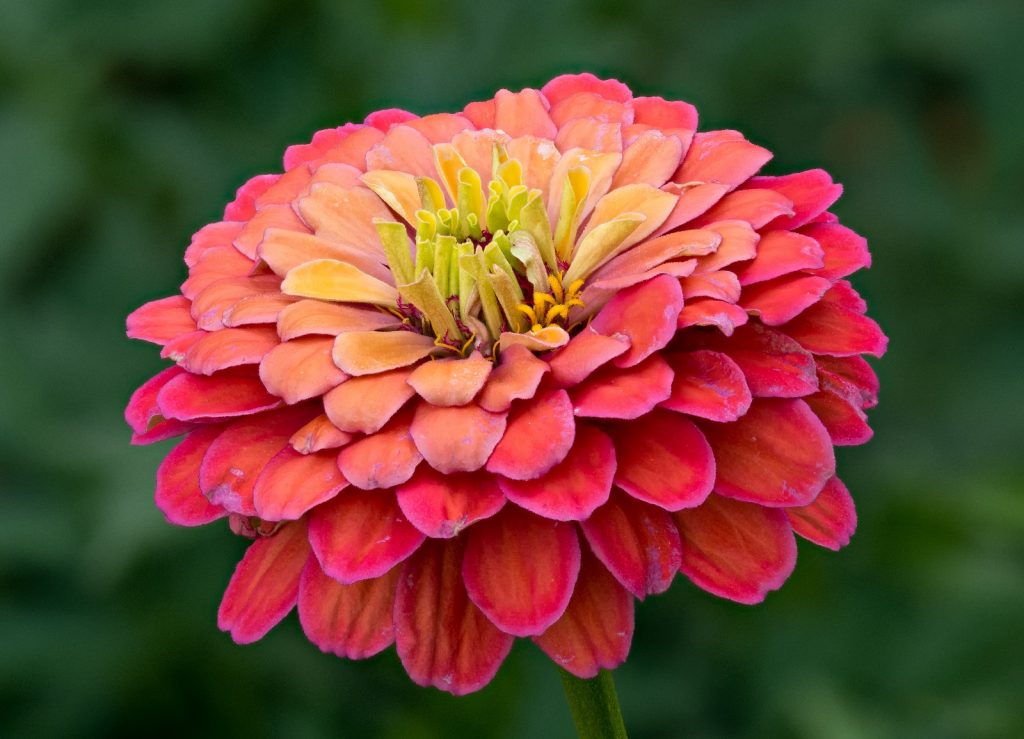
Jasmine
Originating from humid, tropical zones, there are over 200 species of this popular and highly fragrant plant. Jasmine is one of several sun-friendly plants that hummingbirds love thanks to its hardiness in warm weather, its potent scent, and its fertile stores of pollen and nectar. It’s considered one of the best hummingbird flowers thanks to its reliability – and what’s more, certain varieties will also welcome large droves of butterflies and bees.
Mostly flowering in white, cream, or yellow, jasmine is an attractive specimen that can grow happily in the ground or a container. It loves to climb and spread, meaning that if confined in a container, it is likely to need support.
Jasmine can take a little time and patience to grow to full fruition, and as a keen grower and climber, you may need to plan your space ahead for how you’d like it to stretch out. This plant works brilliantly climbing trellises and fencing, for example, and it makes for a fabulous hummingbird-friendly flower screen.
As there are hundreds of jasmine plants out there, take your time to find a specimen that appeals to hummingbirds specifically – such as the white jasmine, a highly prolific grower that tends to appeal to hummers more than any other.
Watering and feeding jasmine should only ideally take place once or twice a week at most – these crawlers won’t need much encouragement, providing they have enough light.
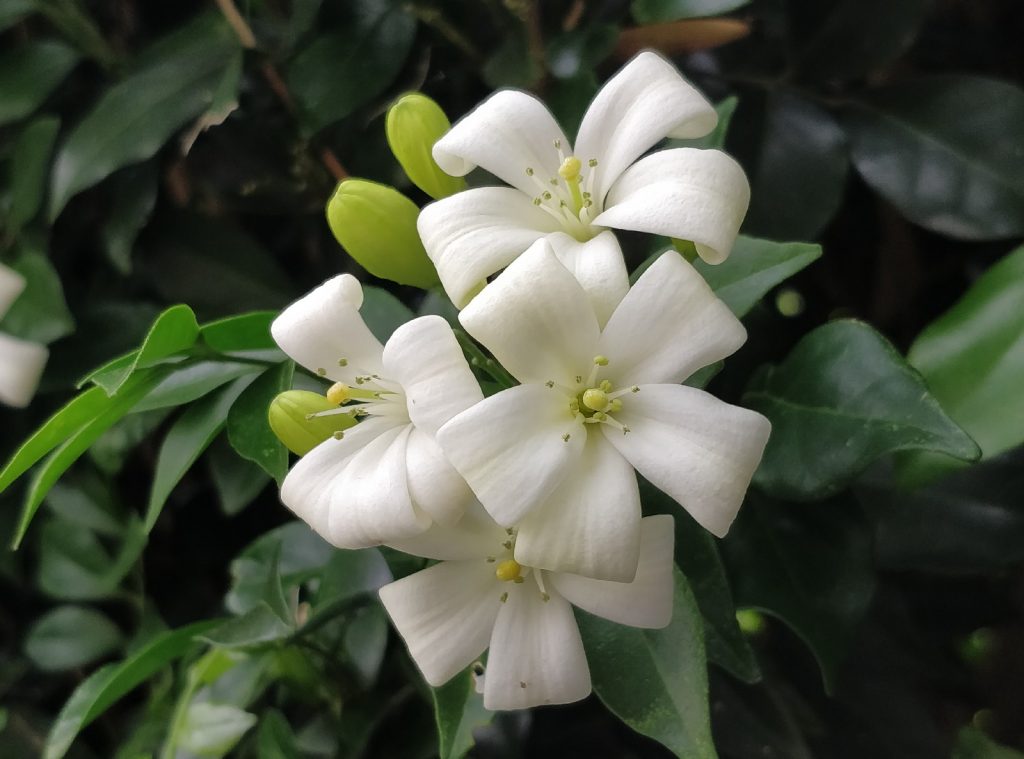
Gladiolus
Hummingbirds adore gladioli – they are stunning ‘statement’ plants, are easy to spot from a distance, and have trumpet-shaped flowers perfect for beaks and tongues to dip into. They are statuesque flowers that stand proudly on strong, upright stems, with flowers forming from bottom to top in sequence. They unfurl gently, allowing hummingbirds to delicately dip in and take a feed.
Gladioli often have contrasting central colors of yellow, lemon, pale pink, and even a very light green. Hummingbirds will generally return to gladioli time and again thanks to their reliable nectar supplies – they’re some of the most fertile on our list. They can grow to around four feet tall at largest, perfect for low-hovering hummingbirds.
Gladioli are impressively hardy, though they will normally only withstand the cold if you grow them in USDA zones seven up to ten. You’ll need to try and keep these flowers growing in sandy soil that drains well, and they’ll also thrive in raised beds. Sadly, they will fade quickly in a matter of weeks, which means you may need to replant them frequently to keep your garden growing. Keeping their flowers rolling in this way effectively means you can welcome more hummingbirds for longer.
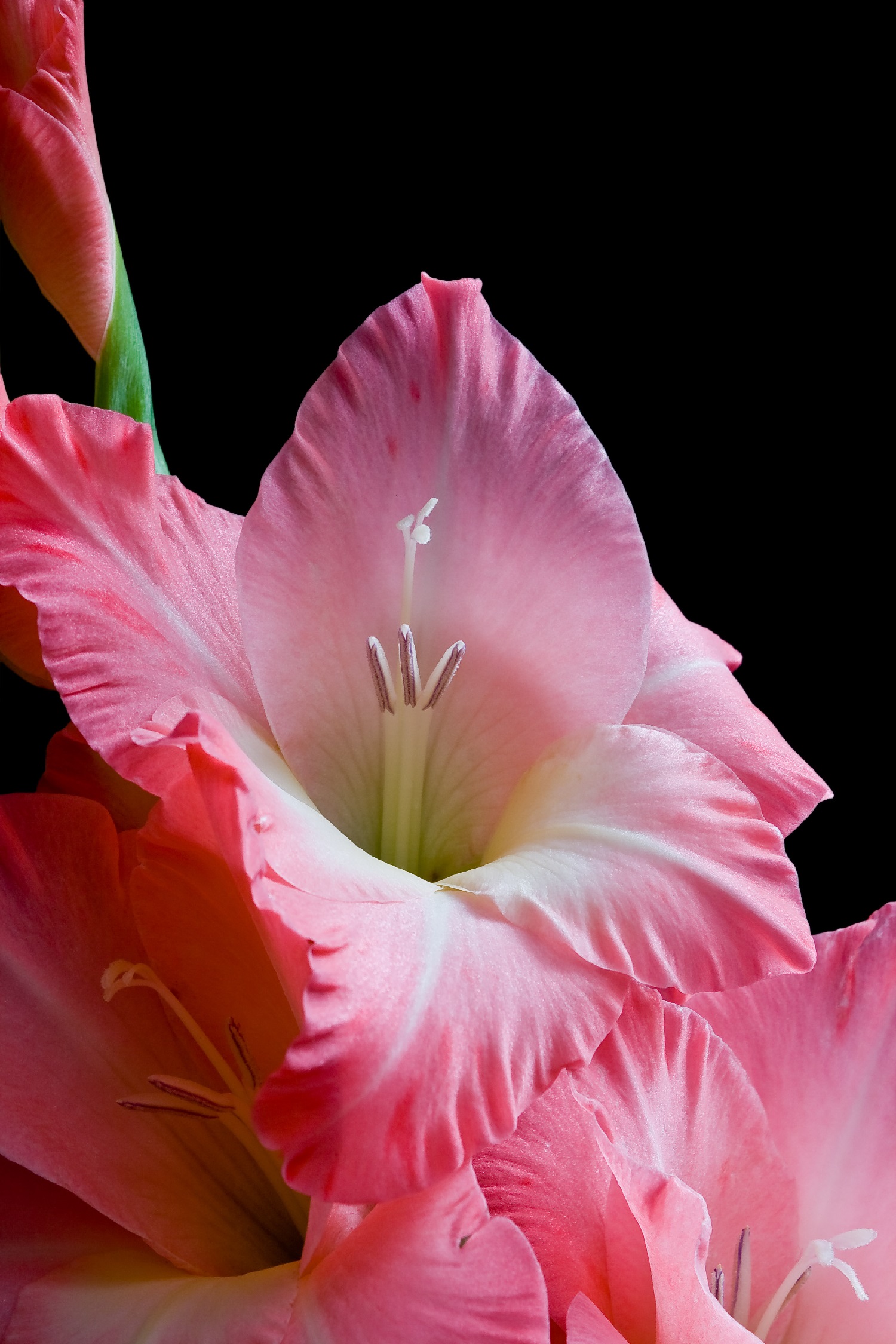
Hydrangeas
Hydrangeas are a bit of an oddity – in that some species, such as mopheads, are almost infertile. Most hydrangea species will attract hummingbirds but won’t always convert so willingly on nectar. Their flowers can burst into deep pinks through shades of burgundy, pale pink, lemon, yellow, white, blue, and lilac – and sometimes with a greenish hue. This wide palette means hydrangeas are likely to catch the eyes of hummingbirds and butterflies alike, even if they don’t deliver much food.
When growing, hydrangeas are generally reliable and can be hardy if treated well. They enjoy the sunshine but can wilt if undernourished – and will die off if left unwatered. Hydrangeas will also need space to spread – it is possible to grow them in containers, but they may need stakes for support in windy spots, and fertilizing from time to time.
Hydrangeas fare best in USDA zones three through to nine and are planted mainly as ‘live ornaments’ – they don’t tend to add much to pollination, but they can look and smell delightful.
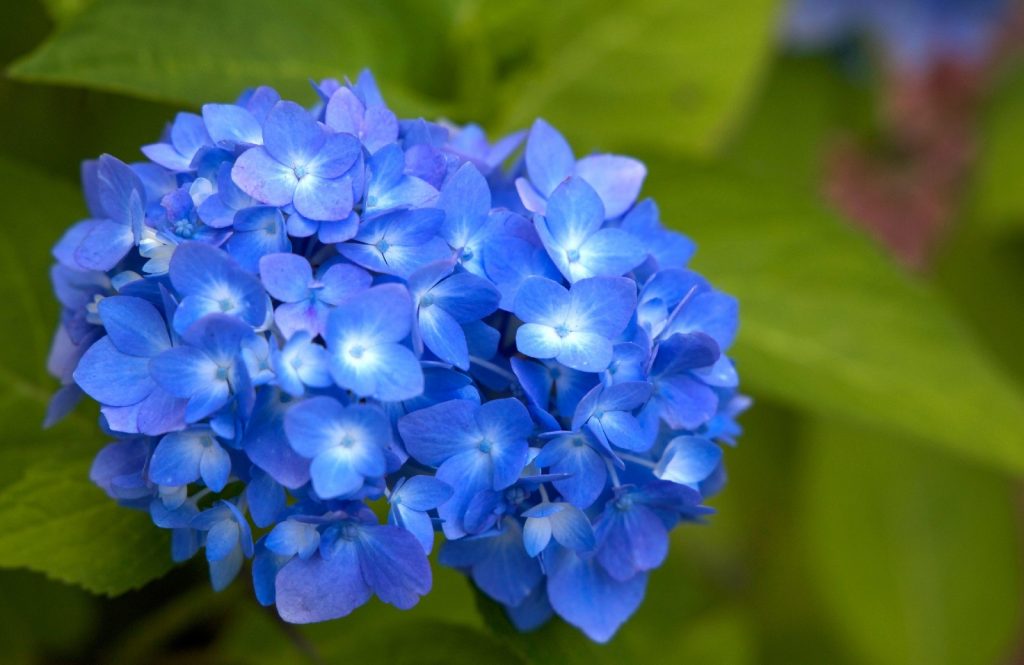
Rose of Sharon
Rose of Sharon is one of several species of hibiscus that attracts hummingbirds thanks to its abundant nectar cavities. It has beautifully colored flowers, often with deep pink outer edges of petals that gradually fade to a paler pink. The centers of these flowers stand out especially to hummingbirds to help highlight the nectar, and they’re tube-shaped to allow ease of feeding.
As with roses, deadheading this hibiscus is worthwhile to encourage more growth during the season – and to welcome as many hummingbirds as possible. This plant responds well to occasional fertilizer, particularly in the growing and flowering season of late summer.
Preferring a sunny or semi-shaded position, the Rose of Sharon can be grown in a container, though this will restrict its growth – it typically grows best in the ground. Flowering in late summer, it may need support to stand. For the hardiest of flowers, you’ll do best growing these plants across USDA zones five up through nine.
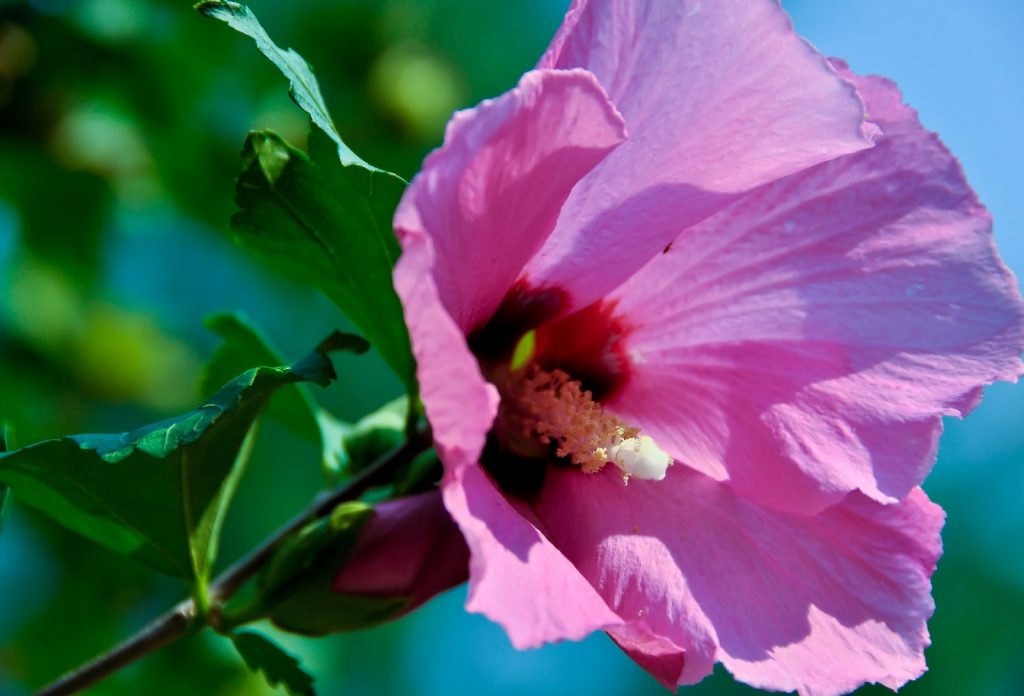
Foxgloves
Deadly but delightful to look at, foxgloves are fascinating flowers that scientists believe evolved thanks to hummingbird pollination. They’re long and bell-shaped, drooping down to give hummers easy access while hovering and feeding. These flowers are said to have developed their shape to help hummers reach nectar easier.
Sometimes confused with snapdragons (a fatal mistake if eaten!), foxgloves grow in vibrant pinks, yellows, whites, and purples. They are lengthy and statuesque, reaching up to six feet in height in extreme cases. In most scenarios, the average foxglove will stop growing much shorter, ideal for hovering hummingbirds to access.
These plants thrive in full sun or partial shade – and in very hot zones, they will typically fare best with some form of shade. They grow comfortably in zones four through ten and will need well-draining soil rich with nutrients and adequate moisture. These biennial plants, grown from seed, will not flower in the first year – so patience is a must!
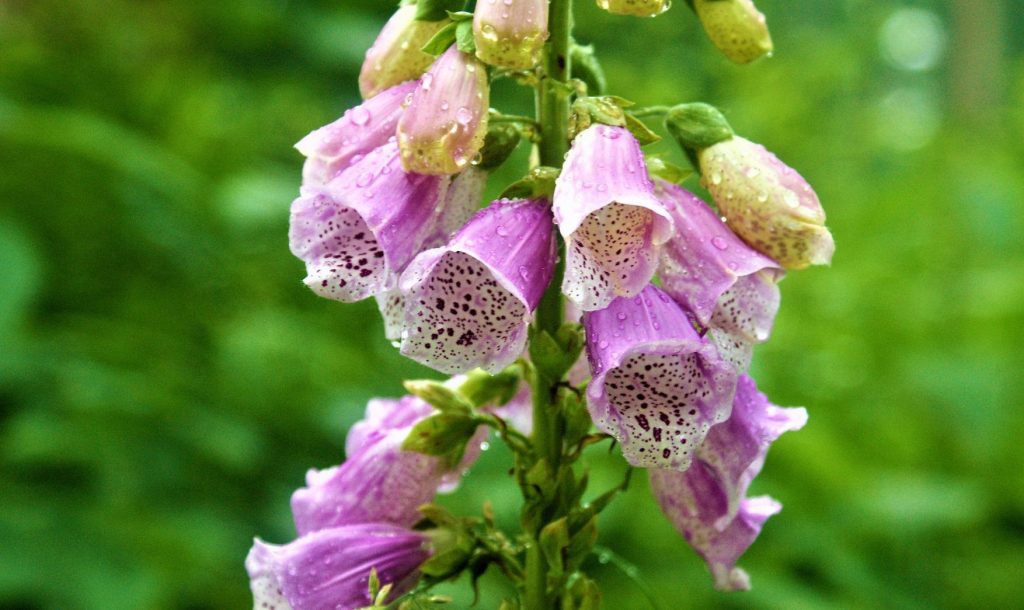
Verbena
The verbena is another plant that’s popular with hummingbirds thanks to its sheer abundance of nectar. This is a type of verb that’s popular with bees, butterflies, and even chefs – it’s been used in medicine as well as various recipes. Verbena arrives in many different species and varieties, though will typically all possess deep, fragrant pockets of petals that grow in blues, purples, and whites, depending on the variant. Hummingbirds can easily poke beaks into verbena flowers for quick feeds, though they will have fierce competition from other pollinators in your garden.
Verbena plants are typically very straightforward to grow and propagate, though if growing from seed, make sure to plant and water them from warmer months onwards. You’ll normally expect to see these plants fare well in USDA zones nine through to 11, though a word of warning – some species are considered invasive and may even be treated as weeds across the US. Regardless, they are some of the ‘safest’ choices if you want to welcome hummingbirds to your yard.
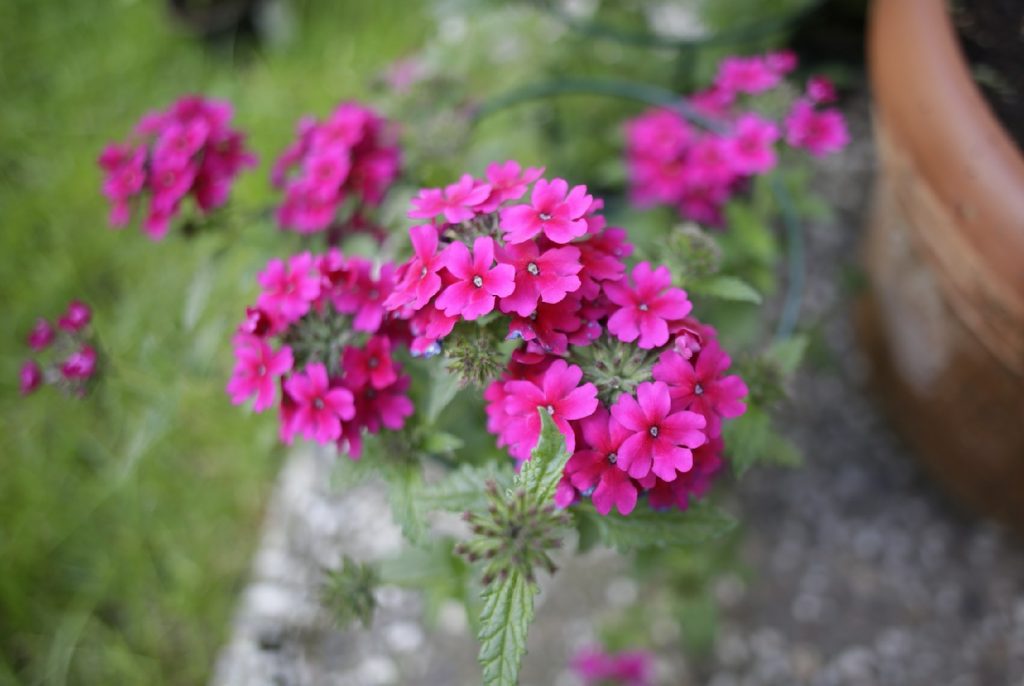
Is it easy to grow hummingbird flowers?
That depends on where you live, and the time and effort you are willing to put into caring for them! As you can see, there are plenty of flowerbed blooms that hummingbirds love which shouldn’t require much effort to grow. However, there are also plenty of potted and hanging plants that attract hummingbirds, too. Again, they are perhaps less picky than we assume them to be!
That said, every wild yard or garden is different. Have you attracted any hummingbirds of your own? What are your favorite flowers for bringing these beautiful critters back to your space time and time again?
